WINTER
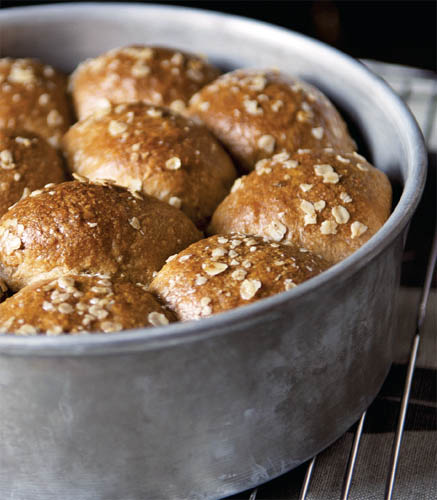
Fig and Blue Cheese Savouries
Warm Orzo Salad with Beets and Greens
Warm Custard Spoon Bread
Sweet Potato and Pancetta Gratin
Heavenly Oatmeal Molasses Rolls
A Medley of Roasted Potatoes with Homemade Za’atar and Aleppo Pepper
Mulled White Wine with Pear Brandy
Kentucky Hot Toddy
Mujaddara with Spiced Yogurt
Pastitsio
Short Rib Ragu
Hunter’s-Style Chicken
Not-Too-Virtuous Salad with Caramelized Apple Vinaigrette
Crispy Spice-Brined Pecans
Roasted Fennel and White Bean Dip
Tamatar Biryani (Tomato Rice)
Linguine with Sardines, Fennel, and Tomato
Aunt Mariah’s Lemon Sponge Cups
Clementine Pound Cake
Gong Bao Ji Ding (Gong Bao Chicken)
Chicken That Fancies Itself Spanish, with Lemons, Onions, and Olives
Creamy Potato Soup with Bacon Vinaigrette
Coconut Cajeta and Chocolate Fondue
Shrimp Gumbo
Burnt Caramel Pudding
Roasted Broccoli with Smoked Paprika Vinaigrette and Marcona Almonds
WEEK 14 YOUR BEST OPEN HOUSE DISH
Fig and Blue Cheese Savouries

By TheRunawaySpoon / Makes about 36 hors d’oeuvres
WHO: TheRunawaySpoon is based in Memphis, Tennessee, and blogs at www.therunawayspoon.com. She wrote, “I think I am like most people: somewhere in the middle between food snob and food schlub. Just being in the kitchen makes me happy.” See her recipes for Pastitsio and Baked Ricotta and Goat Cheese with Candied Tomatoes.
WHAT: Delicate, crumbly little thumbprints that are the perfect combination of sweet and savory—a cheese plate wrapped into one crunchy little morsel.
HOW: A simple food processor dough yields tender, buttery coins flecked with blue cheese and black pepper. Good-quality fig jam is crucial here; if you can’t find one, quince or pear jam also work well.
WHY WE LOVE IT: TheRunawaySpoon came up with these as an easy hors d’oeuvre she could make on the fly when invited to friends’ houses. Might we suggest that you make two batches?
1 cup all-purpose flour
8 tablespoons (1 stick) unsalted butter, at room temperature
4 ounces blue cheese, crumbled
Freshly ground black pepper
About 3 tablespoons fig preserves
1. Heat the oven to 350°F. Line a baking sheet with parchment paper.
2. Place the flour, butter, blue cheese, and a few grinds of black pepper in the bowl of a food processor and process until the dough just comes together and starts to form a ball.
3. Dump the dough out onto a lightly floured surface and knead a few times to pull it together. Then roll out to a 1/8-inch-thick circle with a floured rolling pin. Cut rounds out of the dough with a floured 1-inch round cutter and transfer to the parchment-lined baking sheet. Reroll the scraps (no more than once) and cut more rounds.
4. Using the back of a rounded ½-teaspoon measure or your knuckle, make an indentation in the center of each dough round. Spoon about ¼ teaspoon of the fig preserves into each indentation, using your finger to push the preserves as best as possible into the indentation.
5. Bake the savouries until the preserves are bubbling and the pastry is light golden on the bottom, 10 to 12 minutes. Let cool on the baking sheet for at least 10 minutes, then remove to a wire rack to finish cooling.
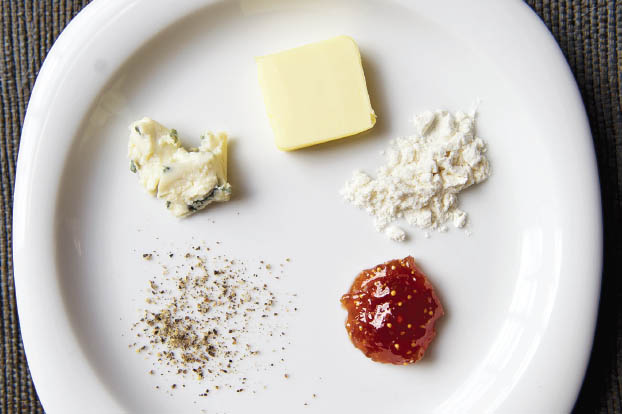
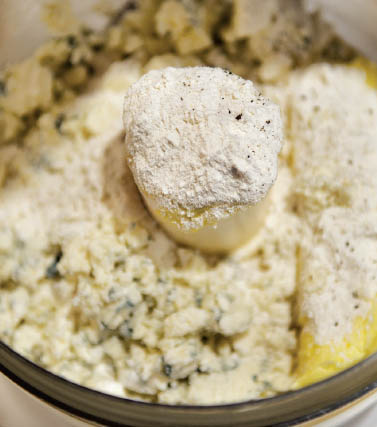
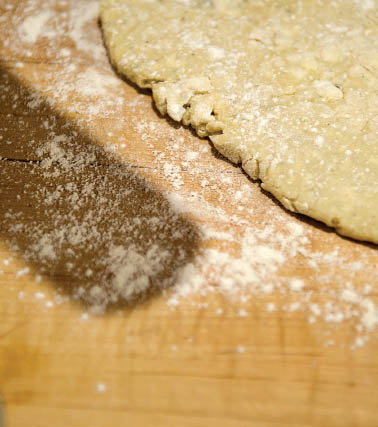
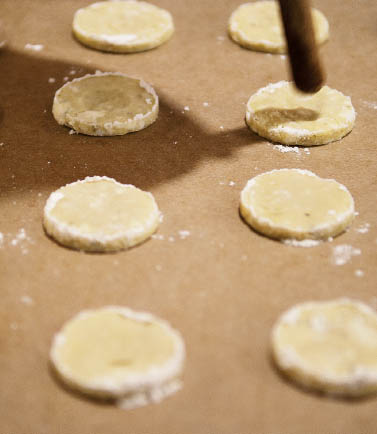
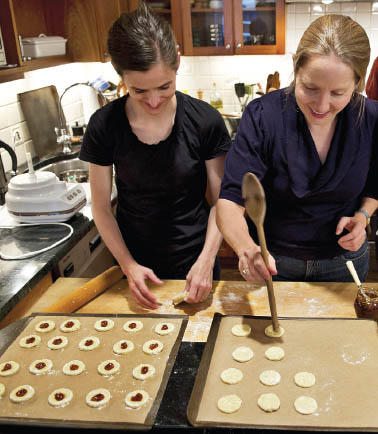
WHAT THE COMMUNITY SAID
JENNIFER ANN: “I made these last night for friends and they are definitely going into heavy rotation this holiday season—so much flavor with so little effort. Thanks for a wonderful recipe!”
KAYB: “Learned something very important, making these today: Two batches is not enough!”
TIPS AND TECHNIQUES
STINKYCHEESE: “I just made these and they were fabulous. I used whole wheat pastry flour and added two ounces sharp English cheddar because I only had two ounces of blue. Love the fig jam all gooey on top.”
ZINGYGINGER: “They were a tad fragile when made to 1/8-inch thickness, so I made the second batch about 3/8 to ¼ inch thick and they were much easier to pick up without falling apart in my fingers.”
LMACFGREEN: “They freeze beautifully, jam and all! (Just put a little waxed paper between the layers when you pack them for the freezer.) They are the perfect thing to have on hand when you need to pull out something really good, and even better, homemade, for a yummy appetizer.”
IVYG: “Scored a home run with my book club! Because I was running out of time, I chilled the dough, then rolled it out and just cut into 1-inch squares with a pizza cutter. The entire prep time was literally 5 to 10 minutes. Thank you for making me look good.”
WEEK 14 WILDCARD WINNER
Warm Orzo Salad with Beets and Greens
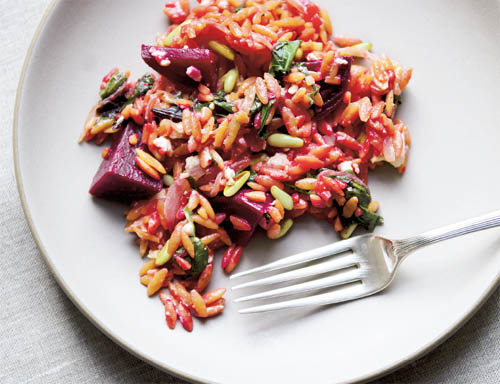
By the parsley thief / Serves 6
WHO: the parsley thief is a stay-at-home mom, blogger, and part-time caterer in Norwalk, Connecticut. She blogs at www.parsleythief.com.
WHAT: A warm orzo salad that mingles caramelized red onions, salty bursts of feta, tender beets, woodsy greens, and crunchy toasted pine nuts.
HOW: The salad is stained fuchsia from cooking the pasta in the same tinted water as the beets, a thoughtful detail we love.
WHY WE LOVE IT: Seasonal, smart, and beautiful, this dish would look striking on a holiday buffet or alongside a handsome roasted bird.
¼ cup pine nuts
12 ounces medium beets with greens attached
2 tablespoons extra virgin olive oil
½ medium red onion, thinly sliced
2 garlic cloves, minced
8 ounces orzo
3 ounces feta cheese, crumbled
Kosher salt and freshly ground black pepper
1. Toast the pine nuts in a dry skillet over medium heat until they begin to brown. Watch carefully, as they will burn in a flash. Remove from the heat and transfer to a bowl to cool.
2. Remove the beet greens and reserve. Peel the beets and chop them into bite-size pieces. Remove the stems from the beet greens and slice the leaves into strips. Wash the greens thoroughly to remove any grit.
3. Heat the olive oil in a large skillet over medium heat. Add the red onion and garlic and cook until the onion is tender and golden brown, 10 to 15 minutes. Reduce the heat to medium-low and add the beet greens. Cover and cook, tossing occasionally, until the greens are wilted, about 5 minutes.
4. Meanwhile, cook the beets in a pot of boiling salted water until just tender, 10 to 12 minutes. Remove the beets from the pot using a slotted spoon and set aside.
5. Return the water to a boil and add the pasta. Cook until al dente; drain.
6. Transfer the orzo to a bowl, add the beets, pine nuts, beet greens, and crumbled feta, and toss. Season with salt and pepper to taste and serve.
WHAT THE COMMUNITY SAID
FUHSI: “I’ve made this recipe several times, and am right now making it again. The second time I strayed from the recipe, increasing the ratio of beets to orzo, but I have reverted back to being true to stated amounts, because the texture as is cannot be surpassed.”
ALLIE: “This is why I love Food52—I’d never think to make something like this; it’s seasonal, easy, and interesting. Thank you!”
MELISSA WHITFIELD CONWAY: “I had this the next day at a friend’s, cold out of the fridge, and it was amazing! The sweet flavor of the beets and the feta were great together. I can’t wait to make this for my family.”
TIPS AND TECHNIQUES
PARSLEYTHIEF: “If you don’t have pine nuts, slivered almonds are a great inexpensive substitute.”
TAIL.FEATHERS: “Loved this! I jumped the gun and started roasting my beets before reading the boiling instruction. No biggie—I just diced and added at the end. So delish!”
BLISSFULBAKER: “Often I want to increase/decrease something in a recipe, but not here. The only substitutions I made were almonds for the pine nuts and Israeli couscous for the orzo (because that’s what I had in my cupboard). Thanks for a wonderful recipe. It’s a keeper!”
WEEK 15 YOUR BEST HOLIDAY BREAKFAST
Warm Custard Spoon Bread
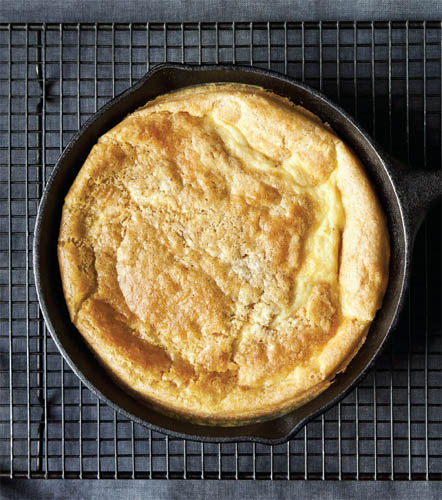
By LocalSavour / Serves 6 to 8
WHO: LocalSavour is based in Austin, Texas, and blogs at www.localsavour.com.
WHAT: An indulgent special-occasion breakfast that is out of this world with a drizzle of maple syrup and some crispy bacon.
HOW: An easy, two-bowl, mix-the-dry-with-the-wet approach yields a creamy, heavenly pudding.
WHY WE LOVE IT: A cross section of this layered dish reminded us of those sand jars you make in elementary school: the supple white custard center is flanked by a sunny corn bread base and a paler cap of tender white cake scented with nutmeg.
1 cup all-purpose flour
¾ cup stone-ground cornmeal
2 teaspoons baking powder
½ teaspoon baking soda
1 teaspoon freshly grated nutmeg
½ teaspoon sea salt
2 large eggs
2 cups milk (I use 2%)
2 tablespoons plus 2 teaspoons unsalted butter, melted
1½ tablespoons white vinegar
1 tablespoon vanilla extract
1 cup heavy cream
1. Heat the oven to 350°F. Place an ungreased 8-inch square baking dish in the oven on the middle rack to warm.
2. Mix the dry ingredients together in a large bowl.
3. In another, large bowl, whisk together the eggs, milk, 2 tablespoons of the melted butter, the vinegar, and vanilla. Add the dry ingredients and slowly stir until the batter is smooth and free of lumps.
4. Remove the heated baking dish from the oven and add the remaining 2 teaspoons butter, using a brush to coat the base and sides of the dish. Slowly scrape the batter into the dish and place it on the oven rack. Slowly pour the cream over the batter; do not stir. Bake for 45 to 50 minutes, or until the top layer is golden brown and a knife comes out clean. Remove from the oven and let stand for 10 minutes before serving.
5. Enjoy!
WHAT THE COMMUNITY SAID
EFOOD: “I made this for brunch today, along with a root vegetable hash. It was wonderful.”
LOBSTERBRIEAVOCADOBREATH: “Wow! This is a fabulous fusion of corn bread, pancake, and delicate custard delight.”
BFUL: “This is scrumptious. A nice variation on the standard spoon bread recipe. I made it Christmas Eve morning. Family loved it. Served with bacon, orange juice, and freshly brewed dark coffee.”
TIPS AND TECHNIQUES
MRSLARKIN: “I made this for brunch today, and since I don’t own an 8-inch square baking dish, I experimented with individual straight-sided ramekins, and it works! I had a mish-mosh of sizes, but I think if you use about 10 ramekins that hold about 2/3 cup liquid, you’ll have cute little rustic-looking spoon breads.”
HARDLIKEARMOUR: “Made this for breakfast this A.M. Used polenta, and had to do a mix of cream and half-and-half. Came out beautifully!”
WEEK 15 WILDCARD WINNER
Sweet Potato and Pancetta Gratin

By cnevertz / Serves 12
WHO: cnevertz is based in New York City.
WHAT: Individual sweet potato gratins given a big punch of flavor from diced pancetta and Gruyère.
HOW: Use a muffin tin for easy portioning. If you choose your sweet potatoes carefully, the slices will fit perfectly into each cup to make more polished personal gratins (if you care about that sort of thing—take note, Type As!).
WHY WE LOVE IT: This is far from a “sweet” sweet potato dish. The more intense the Gruyère, the deeper the dish goes into savory territory. We say, “Bring it on!”
2 medium sweet potatoes (1 pound)
4 ounces Gruyère cheese, shredded (1 cup)
4 ounces pancetta, cut into small dice (1 cup)
¼ teaspoon salt
1/8 teaspoon freshly ground white pepper
¾ cup heavy cream
1. Heat the oven to 400°F. Generously coat a 12-cup muffin tin with butter, oil, or nonstick cooking spray.
2. Peel the sweet potatoes and slice into 1/8-inch-thick rounds. Put a slice of the sweet potato into each muffin cup. Top each with about a teaspoon of the shredded Gruyère and diced pancetta; sprinkle with a little salt and white pepper. Repeat twice, overlapping smaller sweet potato slices if necessary to make a full layer and using all the slices. Scatter the remaining cheese and pancetta on top. Spoon a tablespoon of heavy cream on top of each gratin.
3. Cover the pan loosely with a sheet of aluminum foil. Bake for 20 minutes. Remove the foil and bake, uncovered, for 20 to 25 minutes, until the sweet potatoes are tender.
4. Allow to cool for 10 minutes before removing the gratins from the muffin tin and serving.
WHAT THE COMMUNITY SAID
JENNIFER ANN: “Brilliant idea! And just in time to solve my side dish dilemma for Christmas.”
TIPS AND TECHNIQUES
CNEVERTZ: “Making these in muffin tins allows you to easily multiply the recipe for your guests.”
VBEALE: “This is soooo delicious and easy! Great for entertaining. I substituted shallots for the pancetta to make it vegetarian. Thanks for sharing!”
WEEK 16 YOUR BEST DINNER ROLLS
Heavenly Oatmeal Molasses Rolls
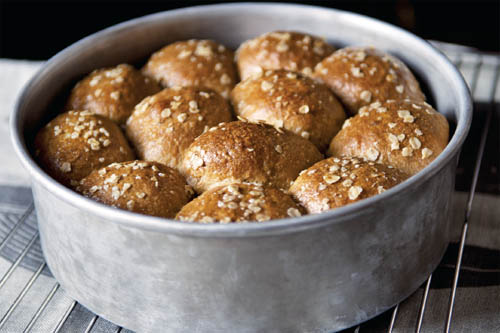
By monkeymom / Makes 12 rolls
WHO: monkeymom is a scientist in the San Francisco Bay Area.
WHAT: Tender, rich dinner rolls, with just a hint of sweetness.
HOW: A straightforward and simple approach to bread making, no machine needed.
WHY WE LOVE IT: Chewy and full of deep flavor from the molasses, these rolls are versatile enough to complement a variety of main dishes. We love the ease of the first refrigerator rise, and these are virtually guaranteed to come out looking beautiful, with their butter-slicked and oat-flecked tops.
2 teaspoons active dry yeast
¼ cup lukewarm water
1 tablespoon dark brown sugar, plus a pinch
¾ cup whole milk
8 tablespoons (1 stick) unsalted butter, cut into cubes
¾ cup rolled oats, plus more for sprinkling
2 tablespoons molasses
2 teaspoons salt
1 large egg
2½ to 3 cups unbleached all-purpose or bread flour
2 to 3 tablespoons unsalted melted butter for brushing
Salted butter for serving
1. Combine the yeast with ¼ cup lukewarm water, and the pinch of brown sugar in a small bowl and let stand until bubbly. (If it doesn’t get bubbly, throw it out and get some new yeast.)
2. Scald the milk (heat it in a small saucepan until it begins to steam and bubbles form around the edges; do not let it boil), then combine with the butter in a large bowl. When the butter has melted, add the remaining tablespoon of brown sugar, oats, molasses, and salt. Blend thoroughly and let cool to lukewarm.
3. Add the egg to the milk mixture and stir well. Add the yeast and mix to incorporate, then mix in 2½ cups flour. Add what you need to of the remaining ½ cup of flour, mixing until the dough loses its sheen. Let rest for 10 minutes.
4. Scrape the dough into a greased bowl. Turn to coat, cover with plastic wrap, and refrigerate for a minimum of 2 hours; it can sit overnight as well. It won’t rise a lot.
5. Generously butter a 9-inch round cake pan. Turn the chilled dough out onto a floured work surface and knead slightly. Cut the dough into 12 pieces and shape into balls. Press each ball flat with your fingers, then roll up and tuck the edges under. Place the rolls seam side down in the buttered pan. Brush all over with half of the melted butter and sprinkle with some oats. Let rise in a warm place until doubled in size, about 2 hours.
6. Heat the oven to 350°F.
7. Bake the rolls until they are nicely browned and sound hollow when you tap their bottoms, 35 to 40 minutes. (The internal temperature, measured with an instant-read thermometer, should be 190°F.) Remove the rolls from the pan and brush generously with the remaining melted butter. Let cool on a rack for 5 to 10 minutes.
8. Serve warm, with salted butter!
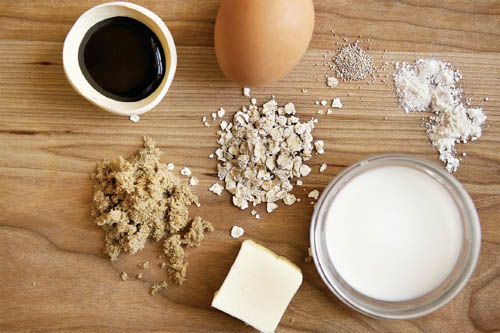
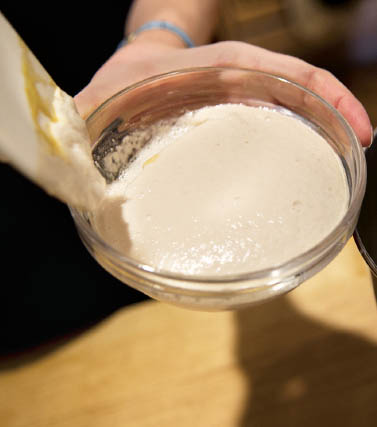
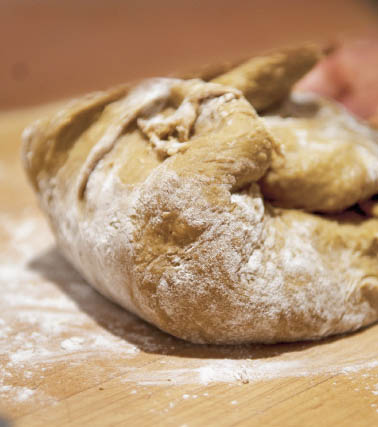
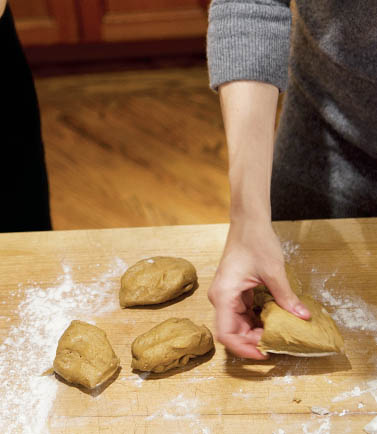
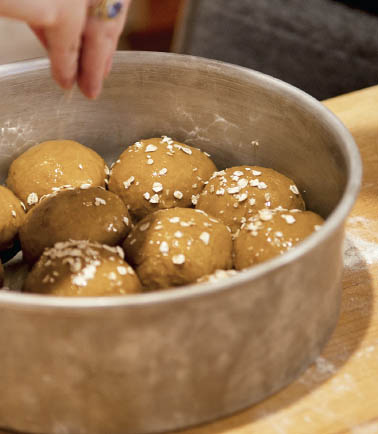
WHAT THE COMMUNITY SAID
ANGEL: “There’s good, and then there’s, OMG don’t lose this recipe good. This recipe is amazing. My husband, who is complimentary but never overly complimentary, couldn’t stop raving about these rolls. Thank you for sharing. We loved it!”
THIRSCHFELD: “I bow to the dinner-roll goddess and the only words that fit, ‘effing unbelievably wonderful’—words I once heard Daniel Patterson say to Grant Achatz.”
KAYKAY: “Yeah! Congratulations. These were so delicious. How lucky am I that we live so close to each other that I get to try many of your new creations right out of the oven?! You can’t ever move out of the neighborhood.”
WEEK 16 WILDCARD WINNER
A Medley of Roasted Potatoes with Homemade Za’atar and Aleppo Pepper
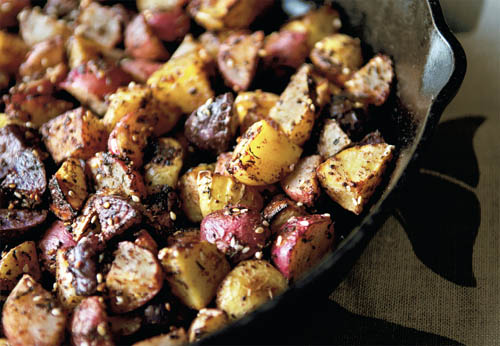
By onetribegourmet / Serves 6 to 8
WHO: onetribegourmet is a Philadelphia-based Realtor who blogs at www.onetribegourmet.com.
WHAT: An inventive recipe that introduces za’atar, a traditional Middle Eastern spice blend, to oven-roasted potatoes.
HOW: onetribegourmet, whose recipe was inspired by a trip to Morocco and Turkey, noted that the za’atar mix can be ground, but we love the extra-crispy bites of potato that result from leaving it coarse.
WHY WE LOVE IT: This dish brings a little taste of the exotic to weekday potatoes. We’re especially thrilled to have a blueprint for mixing our own za’atar to perk up just about anything, from roast chicken to scrambled eggs to a nice grilled steak.
2 to 3 pounds mixed potatoes (I used organic red and purple fingerlings and golden Buttercream potatoes), scrubbed and cut into ½-inch cubes
3 to 4 tablespoons Za’atar (recipe follows)
2 tablespoons Aleppo pepper, or to taste
Juice of 1 lemon
3 to 4 tablespoons extra virgin olive oil
1. Heat the oven to 400°F.
2. In a large bowl, mix the potatoes with the za’atar, Aleppo pepper, lemon juice, and olive oil. Spread in a single layer in a large baking dish or roasting pan. Roast the potatoes, stirring once or twice, until tender and golden brown, about 40 minutes.
Za’atar
3 tablespoons sesame seeds, toasted
2 tablespoons dried thyme
2 tablespoons ground sumac
1 tablespoon sea salt
1. Mix all the ingredients together in a small bowl. You should have about 1 cup.
WHAT THE COMMUNITY SAID
SASHA (GLOBAL TABLE ADVENTURE): “What a simple, tasty spice blend! I always say spices are the best travel souvenirs. Nice work.”
TIPS AND TECHNIQUES
ONETRIBEGOURMET: “You can grind the za’atar in a coffee grinder for a finer texture. I like it coarse for this recipe.”
TXDJINN: “I included the grated zest of the lemon (why let it go to waste?), which added a nice, very subtle taste to the za’atar. This is definitely a keeper. In Arabic, this recipe would be Batata bil za’atar ou harr.’”
A&M: Sumac is a lemony spice commonly used in Middle Eastern cuisine. Both it and Aleppo pepper, a fruity chili with a mild heat, can be found in gourmet markets.
WEEK 17 A & M’S ANNUAL SMACKDOWN / YOUR BEST HOT TODDY
Mulled White Wine with Pear Brandy

By merrill / Serves 4
WHAT: White wine infused with cardamom and star anise, as well as the more traditional triumvirate of cinnamon, ginger, and cloves, and amped up with pear brandy.
HOW: A slice of Asian pear is added to each drink as a garnish—the pear softens slightly as it absorbs the warm booze and makes for a yummy treat once you’ve sipped the last of the wine.
WHY WE LOVE IT: Like a delicate warm sangria, this drink is the perfect accompaniment to a cozy evening indoors.
One 750-ml bottle dry or off-dry white wine, preferably Riesling or Grüner Veltliner
1 piece star anise
Two ¼-inch-thick slices fresh ginger
3 green cardamom pods
3 whole cloves
3 to 4 tablespoons honey, or to taste
¼ cup pear brandy, such as Poire Williams
4 slices Asian pear
1. Put the wine in a medium heavy saucepan with the star anise, ginger, cardamom, cloves, and honey (start with 3 tablespoons and adjust later if necessary). Set the pan over medium heat and bring just to a simmer, stirring occasionally. Turn off the heat and let the wine mull for at least 15 minutes.
2. Taste and add more honey if you like. Gently reheat the wine until it starts to steam, then turn off the heat and stir in the brandy.
3. Divide among 4 mugs or heatproof glasses, putting a few of the whole spices in each mug if you like, and add a slice of Asian pear. Toddy away!
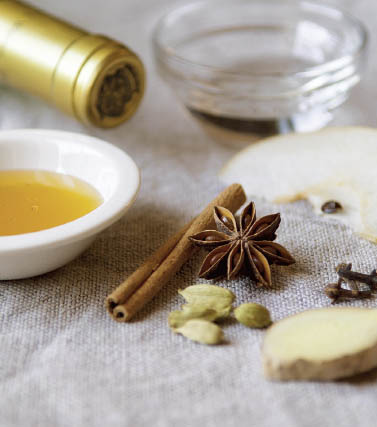
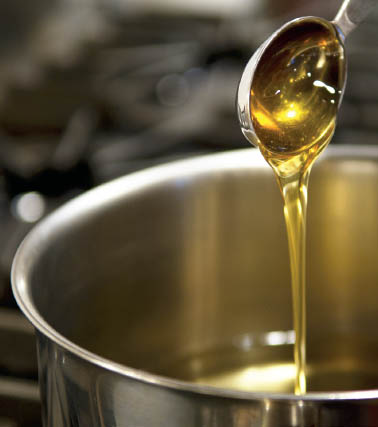
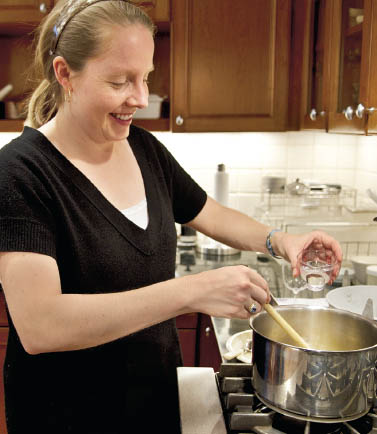
WHAT THE COMMUNITY SAID
MERRILL: “I’m a lightweight when it comes to booze, and I’ll be the first to admit that my interpretation of a ‘hot toddy’ is a little loose. My husband loves Glühwein (German/Austrian mulled wine), but he prefers drinking white wine to red, so for this contest I decided to experiment with a mulled white wine.”
DINA AVILA: “Love the spices you chose. Perfect blend of light and spicy!”
ANTONIAJAMES: “Such a fun, tasty drink! We enjoyed it with Fig and Blue Cheese Savouries this afternoon.”
HARDLIKEARMOUR: “This drink is delicious! I’m somewhat ashamed to say that my husband and I polished off an entire batch. Cheers!”
TIPS AND TECHNIQUES
MERRILL: “Any firmish pear would do nicely. I think a Bartlett would also work well.”
WEEK 17 WILDCARD WINNER
Kentucky Hot Toddy

By Table9 / Serves 1
WHO: Table9 is a Greensboro, Alabama, youth program director and passionate home chef.
WHAT: A refreshing, balanced toddy that won’t make you feel as if you’ve been hit over the head with booze.
HOW: Table9 was adamant about using Maker’s Mark bourbon—“the only true bourbon to drink”—as the base of this toddy.
WHY WE LOVE IT: It turns out that bourbon and citrus are a great match, and just a hint of honey smooth out any rough edges. Cheers!
¼ cup fresh Meyer lemon juice (regular lemon juice will do in a pinch)
½ cup fresh blood orange juice
1 teaspoon honey
1 shot (1½ ounces) Maker’s Mark bourbon
1 cinnamon stick
1. Combine the citrus juices with the honey and bourbon in a tumbler. Add just enough hot water to fill the glass almost to the top. Serve with the cinnamon stick.
WHAT THE COMMUNITY SAID
HARDLIKEARMOUR: “Congrats! What a beautiful drink. Love the blood orange.”
WEEK 18 YOUR BEST LENTILS
Mujaddara with Spiced Yogurt
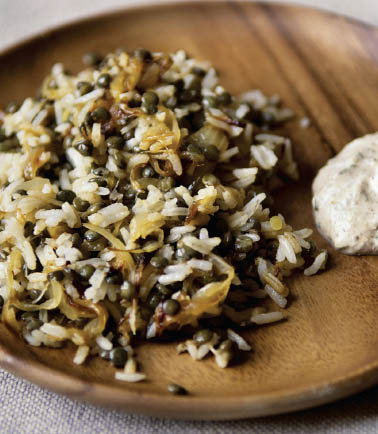
By Rivka / Serves 4
WHO: Rivka is a health care consultant by day, food blogger by night, and she makes a mean veggie chili. Check out her blog at www.notderbypie.com.
WHAT: A storied Middle Eastern staple with varied textures and flavors: crisp, sweet onions tangle with fluffy jasmine rice and tiny, plump French lentils that burst happily in your mouth; the minted spiced yogurt adds zip and ties everything together.
HOW: The rice and lentils are cooked and flavored separately; the magic happens when you allow them to rest together for 15 minutes before serving.
WHY WE LOVE IT: Rivka’s nuanced dish is a meal all its own, and its fragrance lingers long after you’ve taken the last bite.
Mujaddara
¾ cup le Puy lentils (aka French lentils, the tiny dark green ones)
1 teaspoon salt
1 cup jasmine rice
2 tablespoons unsalted butter
3 tablespoons olive oil
6 cups thinly sliced onions (about 3 medium onions)
Yogurt
½ cup whole milk Greek yogurt
½ teaspoon ground cinnamon
½ teaspoon ground cumin (freshly ground if possible)
½ teaspoon ground coriander (freshly ground if possible)
½ teaspoon Aleppo pepper or hot paprika
3 tablespoons chopped fresh mint
Grated zest and juice of ½ a lemon
¼ teaspoon salt
1. To make the mujaddara: Heat the oven to 400°F.
2. Put the lentils, ½ teaspoon of the salt, and 4 cups water in a large ovenproof pot and bring to a boil. Reduce the heat and simmer the lentils until soft but not mushy, about 20 minutes. Drain and set aside. Rinse the pot.
3. Add the rice, the remaining ½ teaspoon salt, and 1½ cups water to the pot, set over medium heat, and bring to a boil. When the water begins to boil, cover the pot, transfer to the oven, and cook for 17 minutes (the tried-and-true Amanda Hesser method!), until perfectly cooked. Remove from the oven, uncover, and fluff the rice with a fork. Set aside.
4. Meanwhile, set a large deep sauté pan over medium-low heat and add the butter and 2 tablespoons of the olive oil. When the butter has mostly melted, add the onions and toss to coat with the butter and oil. After 5 minutes, the onions will soften slightly and start to release some liquid. Raise the heat to medium and cook for 10 to 12 minutes more, until the onions are very soft and browned. Add water by the tablespoon if the pan gets too dry or if the onions start to stick.
5. When the onions are well-browned, add the last tablespoon of olive oil and raise the heat to high. Cook for another 3 to 4 minutes, until the bottom layer of onions has charred and crisped; don’t stir too much or the onions won’t crisp up. Remove from the heat.
6. Combine the rice, lentils, and most of the onions in a large serving bowl and let sit for at least 15 minutes to marry the flavors. (Truth be told, this dish improves with age.) Taste and add more onions, if desired.
7. Meanwhile, make the yogurt: Mix all the ingredients together in a small bowl.
8. If the mujaddara has cooled significantly, reheat it in a low oven or even in the microwave for a couple of minutes. To serve, place a big scoop of mujaddara on each plate and top with a dollop of yogurt.
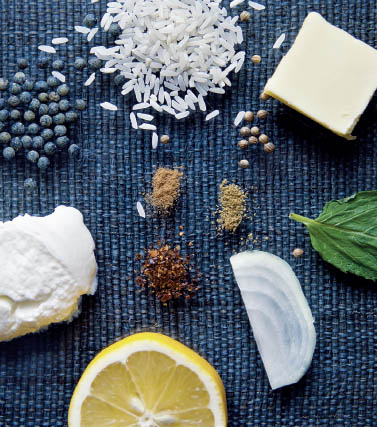
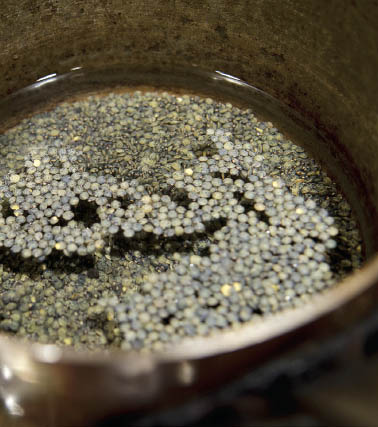
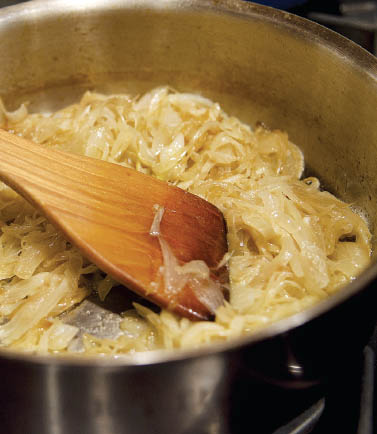
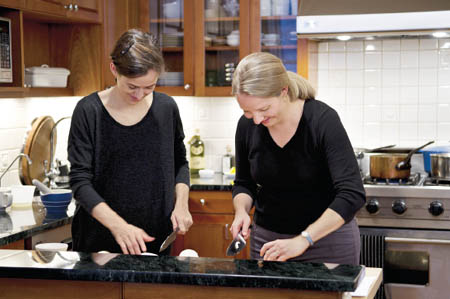
WHAT THE COMMUNITY SAID
SCOFF: “Anyone still wondering if they should try it: it’s amazing—so much more than the sum of its parts. Rivka, you’re a star.”
BOULANGERE: “I love this and consider its discovery one of the high points of my year. I’m making it next week with some black Beluga lentils.”
DRKATE: “Terrific! Thank you—I made this for brunch today. Honestly, this is a recipe I would want to be remembered for.”
STESKER: “I love that everything in this recipe is right in my pantry. It’s just about the yummiest ‘meatless Monday’ dish I’ve ever made. My two-year-old gobbles it up with gusto. And the leftovers are even better.”
TIPS AND TECHNIQUES
DRBABS: “If you use oil to sauté the onions and serve the yogurt on the side, you have your vegetarian and vegan dishes all in one.”
WEEK 18 WILDCARD WINNER
Pastitsio
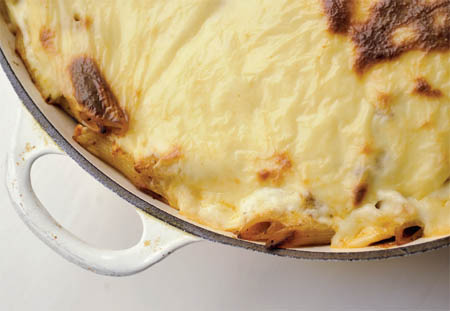
By TheRunawaySpoon / Serves 8
WHO: Read more about TheRunawaySpoon and see her recipe for Fig and Blue Cheese Savouries; see her recipe for Baked Ricotta and Goat Cheese with Candied Tomatoes.
WHAT: Shepherd’s pie meets moussaka—a lamb ragout spiced with cinnamon, oregano, sumac, and mint is blended with penne and feta and then topped with a cayenne-scented béchamel.
HOW: After a bake in the oven—we turned up the heat to 450°F for the final 10 minutes—this hearty dish emerges crisp on the perimeter with a thick toasted-béchamel cap.
WHY WE LOVE IT: We made a quadruple batch of this recipe, which was last year’s Baked Pasta runner-up, for a dinner party and were reminded just how great the dish is. We immediately decided it deserved a spot in the second Food52 cookbook. It’s an all-around, anytime winner.
Pastitsio
1 pound dried penne or ziti
1 tablespoon unsalted butter
2 pounds ground lamb
2 medium onions, chopped
½ cup dry red wine
One 6-ounce can tomato paste
1 teaspoon ground cinnamon
1 tablespoon dried oregano
½ teaspoon ground sumac (optional)
1 teaspoon dried mint (optional)
Salt and freshly ground black pepper
Cheese Sauce
6 tablespoons unsalted butter
½ cup all-purpose flour
3 cups whole milk
1/8 teaspoon cayenne pepper
¼ cup freshly grated Parmesan cheese
6 ounces feta cheese, crumbled
1. Cook the pasta in a large pot of boiling salted water until just al dente, about 3 minutes less than the package directions. Drain, transfer to a bowl, and stir in the butter to prevent sticking. Set aside.
2. Meanwhile, cook the lamb in a large sauté pan over medium heat, breaking it into pieces, until no longer pink, about 8 minutes. Add the onions and cook, stirring occasionally, until soft and translucent, about 5 minutes.
3. Transfer to a colander and shake well to drain the fat. Return the lamb and onions to the pan, add the wine, and cook over medium heat until most of the liquid has evaporated. Stir in the tomato paste, and cook for a minute. Add the cinnamon, oregano, sumac, and mint, if using, and 2 cups of water. Simmer, stirring occasionally, until thickened, 15 to 20 minutes. Season to taste with salt and pepper. Set aside to cool.
4. To make the cheese sauce: Melt the butter in a medium saucepan over medium heat. Whisk in the flour until incorporated, about 30 seconds. Add the milk in a slow steady stream, whisking constantly so there are no lumps. Cook, whisking often, until the mixture is thick and bubbly and coats the back of a spoon, 5 to 7 minutes. Stir in the cayenne and Parmesan. Remove from the heat.
5. Heat the oven to 350°F. Grease a 9 x 13-inch baking dish.
6. Add the pasta to the lamb mixture and stir to combine. Toss in the feta and stir to combine. Spoon the mixture into the greased baking dish. Spread the cheese sauce over the pasta mixture, smoothing the top with the back of a spoon. Bake until browned on top in spots, 35 to 40 minutes.
7. Remove from the oven and allow to cool for about 15 minutes before serving.
WHAT THE COMMUNITY SAID
SARASITA: “Great dish. My husband loves baked ziti, and when I made this, he went crazy for the new twist of Greek flavors, compared to the traditional Italian.”
FLAWLESSMOM: “It was even better the second day. I was so happy for leftovers! Thank you for this recipe and for the suggestion of turning up the heat for the last 10 to 15 minutes. It looked exactly like the picture!”
TIPS AND TECHNIQUES
A&M: A few tips: Remember to salt the pasta water, and you should undercook the pasta because it will continue cooking in the later baking stage. When you add the tomato paste to the lamb, let it toast a bit before adding the water.
THERUNAWAYSPOON: “This can be made in one big family-style casserole, or two smaller sizes. Take one to a friend and have one for dinner.”
MELISSAV: “I made everything but the cheese sauce on Sunday and put it in the fridge. When I came home from work on Monday, I whipped up the sauce and popped it in the oven. Made for a delicious and easy Monday night dinner (and lunch today)!”
ANTONIAJAMES: “Made this last night using beef instead of lamb and fresh mint, not dried. Outstanding! And so easy too.”
WEEK 19 YOUR BEST SHORT RIBS
Short Rib Ragu
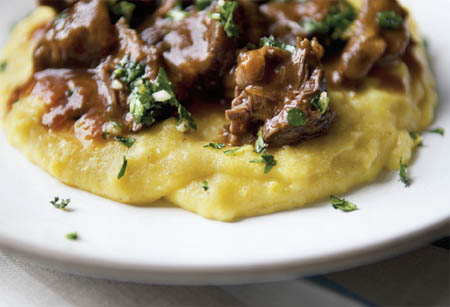
By Minimally Invasive / Serves 8 to 10
WHO: Minimally Invasive, a graphic designer and freelance writer living in Ringwood, New Jersey, is always up for trying something new. Her latest projects are perfecting her smoker technique, as well as turning out the perfect focaccia. She blogs at www.chimeraobscura.com/mi.
WHAT: A hearty, earthy ragu best made a day in advance. We’re confident this would be just as satisfying over pasta as it is over polenta.
HOW: Mushrooms, which are pureed with the rest of the sauce once the short ribs are fall-apart tender, make the liquid cloaking the shredded short ribs nice and meaty, and the wine, anchovy, tomato paste, and mustard make it sing.
WHY WE LOVE IT: Minimally Invasive wrote, “Let’s be honest, short ribs are great in any incarnation, but I wanted to use them in a ragu that had a little more oomph than the typical braise, so I went into umami overdrive with porcini.” The gremolata is a nice bright touch at the end. On a frosty winter evening, this would be perfect with a big green salad and the other half of that bottle of red wine.
Ragu
1 ounce dried porcini mushrooms
5 to 6 pounds short ribs
Kosher salt and freshly ground black pepper
1 tablespoon vegetable oil, bacon fat, or lard
1 large onion, chopped
2 medium carrots, peeled and chopped
2 celery stalks, chopped
2 large garlic cloves, finely chopped
2 tablespoons tomato paste
1 tablespoon anchovy paste
Half a 750-ml bottle red wine
One 14-ounce can fire-roasted tomatoes, with their juices
1 tablespoon Dijon mustard
3 to 4 dashes Worcestershire sauce
1 teaspoon dried thyme
1 teaspoon dried oregano
1 large rosemary sprig, leaves removed and chopped
2 bay leaves
4 to 5 cups chicken stock, low-sodium broth, or water
Gremolata
1 large garlic clove, minced
Grated zest of 1 large lemon
¼ cup finely chopped fresh flat-leaf parsley
½ teaspoon salt
1 teaspoon olive oil
Polenta for serving
1. To make the ragu: This is best if prepared one day before serving (see Tips and Techniques). Heat the oven to 350°F.
2. Soak the dried mushrooms in 2 cups boiling water for at least 10 minutes, until soft.
3. Meanwhile season the ribs well with salt and pepper. Heat the oil in a large ovenproof heavy pot (such as a 5-quart enameled cast iron Dutch oven) over medium heat until shimmering. Brown the ribs in batches for 2 to 3 minutes per side; set aside.
4. Pour out all but 1 tablespoon of the fat from the pot, then sauté the onion, carrots, and celery until soft. Add the garlic and stir until fragrant. Create a hot spot in the pot by moving the vegetables aside, leaving about a 3-inch circle bare. Add the tomato paste and anchovy paste to the hot spot and stir vigorously until caramelized, then stir this mixture into the vegetables. Add the red wine to deglaze the pot and cook until the liquid is reduced by half. Add the tomatoes, mustard, and Worcestershire sauce. Lift the mushrooms from the soaking liquid and add to the pot, then add the soaking liquid, minus the last ¼ inch to keep sediment out of your dish, and the herbs.
5. Add the ribs back to the pot, then add enough chicken stock so the ribs are nearly covered. Bring the liquid to a boil, then cover tightly and braise in the oven for at least 3 hours, or until the ribs are fall-apart tender.
6. Remove the ribs from the braising liquid and set aside until cool enough to handle. Meanwhile, remove the bay leaves from the braising liquid and discard. Puree the braising liquid with an immersion blender (or in batches in a regular blender, then return to the pot). Set the pot over medium-low heat to reduce if the sauce seems thin.
7. When the ribs have cooled, remove and discard the bones and any large pieces of fat. Shred the beef and return it to the pot. Let cool to room temperature, skimming any large pools of fat from the surface, and refrigerate overnight.
8. The next day, make the gremolata: Mix all the ingredients in a small bowl and let sit at room temperature for an hour before serving.
9. Remove the solidified fat from the surface of the ragu and reheat. Serve over polenta, sprinkled with the gremolata.
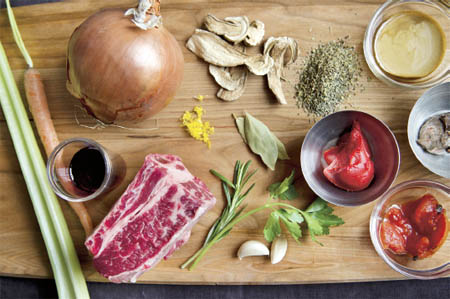
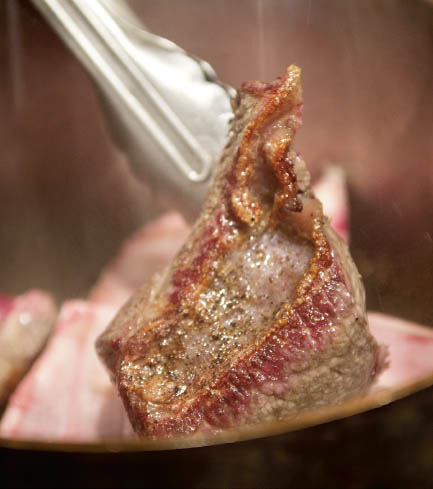
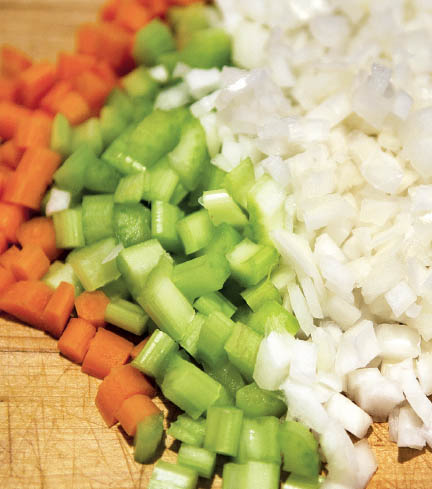
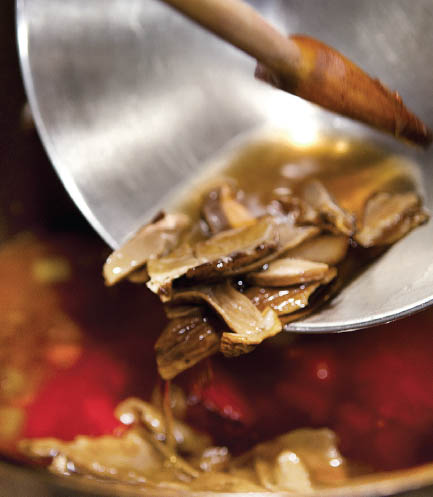
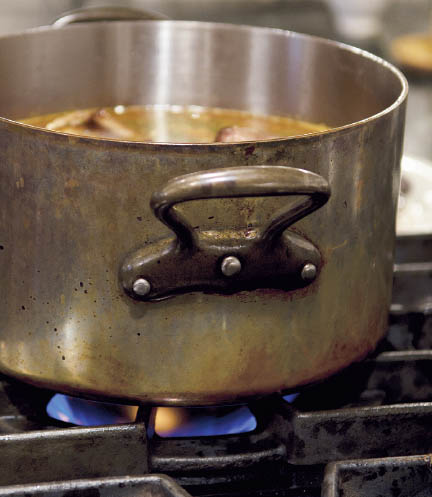
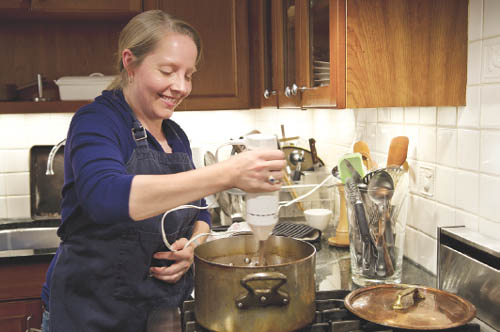
WHAT THE COMMUNITY SAID
BONNIE RAE: “Oh wow! I just made this, and all I can say is ‘Wow!’ This recipe produces an absolutely delicious meal. Good call on the gremolata. That really adds a nice, distinguishing flavor. Bravo!”
TIPS AND TECHNIQUES
MINIMALLY INVASIVE: “You can definitely serve it right away, and I do whenever time is short, but refrigerating overnight helps to remove a bit more fat, and it also lets the flavors mingle more. Like chili, it’s always better on the second day!”
WEEK 19 WILDCARD WINNER
Hunter’s-Style Chicken
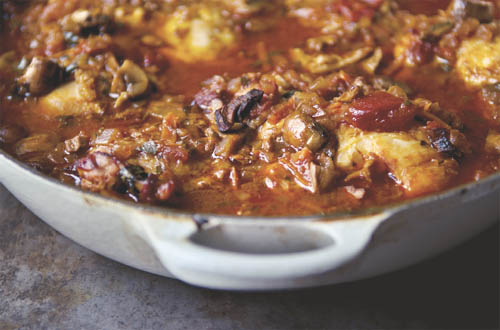
By lastnightsdinner / Serves 4 to 6
WHO: lastnightsdinner lives in Brooklyn, New York, and describes herself as a “desk jockey by day, home cook and food blogger by night.” She blogs at www.lastnightsdinner.net. See her on Linguine with Sardines, Fennel, and Tomato.
WHAT: A riff on chicken cacciatore (brushing up on our culinary Italian, we learned that cacciatore means “hunter’s-style”).
HOW: A few details set this apart from other braised chicken dishes you may know: the subtle perfume of the sweet vermouth (we recommend pouring yourself a nip while the chicken simmers away), the sauce-bolstering grated carrot, and the one-two mushroom punch of dried porcini and fresh cremini.
WHY WE LOVE IT: As lastnightsdinner noted, “There’s a bit of prep involved at the start, breaking down the bird, browning it in batches, soaking the dried mushrooms and sautéing the fresh, and building layers of flavor in your pot, but once everything is in the oven with its parchment cap in place, you can kick back with a Negroni and enjoy the aromas wafting your way.” Serve with your favorite comfort carb—polenta, mashed potatoes, or couscous would all be happy landing pads for the rich, warming sauce and tender shreds of chicken.
One 3- to 3½-pound chicken, in pieces, or an equivalent amount of skin-on parts of your choice
Kosher or sea salt
1 cup dried porcini mushrooms
Grapeseed oil
Extra virgin olive oil
8 ounces cremini mushrooms, trimmed and quartered
¼ cup sweet (Italian/red) vermouth
2 cups chopped white or yellow onions
1 small carrot, peeled and grated (about ½ cup)
3 cups chopped ripe plum tomatoes (or an equivalent amount of canned San Marzano plum tomatoes)
1 tablespoon tomato paste, preferably double-concentrated
Pinch of red pepper flakes
1 cup dry red wine
3 tablespoons chopped fresh herbs (I used a mixture of thyme, savory, and flat-leaf parsley)
1. Heat the oven to 325°F.
2. Arrange the chicken pieces on a platter and pat dry. Season well with salt and set aside.
3. Cover the porcini with 1 cup boiling water and let steep until the mushrooms are soft, at least 10 minutes.
4. Remove the mushrooms from the soaking liquid and finely chop; strain the soaking liquid through a coffee filter to remove any grit, and set aside.
5. Heat a glug of grapeseed oil and a glug of olive oil over medium heat in a heavy ovenproof pot (such as a large enameled cast iron Dutch oven) and brown the chicken in batches, starting skin side down, until the chicken is browned and crisp-skinned. Remove the chicken pieces to a plate or platter and set aside. Pour off all but a thin layer of the rendered fat from the pot.
6. Add the cremini mushrooms to the pot, and cook, stirring occasionally, until browned on all sides. Add the chopped porcini and vermouth and cook until the liquid has evaporated. Remove the mushrooms to a bowl and set aside.
7. Add the chopped onions to the pot, along with a sprinkle of salt and a little more oil if necessary, and cook until soft and translucent. Add the carrot and stir, then add the chopped tomatoes, tomato paste, red pepper flakes, wine, and reserved mushroom liquid, stir well, and bring to a simmer.
8. Toss the chopped herbs with the mushrooms and add to the pot, stirring well. Nestle the chicken pieces on top—being sure to add any juices that have accumulated—cover the pot with a parchment lid (see Tips), and transfer the pot to the oven. Cook for at least 1 hour, preferably more, until the chicken is falling-apart tender and the sauce is thick and reduced.
WHAT THE COMMUNITY SAID
KAYB: “It’s cold and ugly here in the not-sunny South, and it’s supposed to snow tomorrow, and I don’t care if it does, because I’m going to stay inside and make this! Great recipe, great wildcard!”
TIPS AND TECHNIQUES
LASTNIGHTSDINNER: “The parchment lid is a tip I picked up from Thomas Keller and Michael Ruhlman (from Ad Hoc at Home and The Elements of Cooking). You make a parchment lid with a circle cut out in the center to cover your braise rather than the pot lid. I haven’t tried it with a stovetop braise, but it works like a dream in the oven, allowing the liquid to reduce nicely without steaming the chicken skin and losing all that nice browning you worked so hard for! It’s also really easy to peek in and see how much your liquid is reducing, and add more water or whatever if needed. It’s a pretty neat trick, and I’ve been really happy with the results.”
FIVEANDSPICE: “Made this a couple of nights ago—except I used bacon for some extra umami, instead of the porcini, since I had some wonderful, smoky local bacon. It was delicious!”
EGGPLAYER: “I didn’t have vermouth, so I used Marsala. It came out fabulous.”
WEEK 20 YOUR BEST SALAD WITH APPLES
Not-Too-Virtuous Salad with Caramelized Apple Vinaigrette
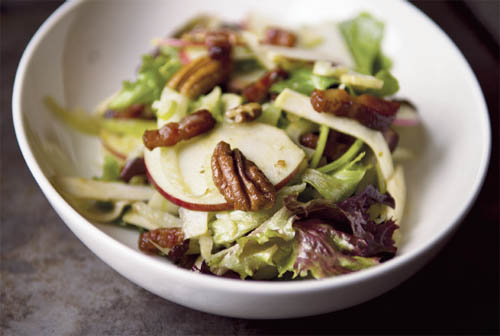
By wanderash / Serves 4 to 6
WHO: wanderash is a mom, caterer, and writer living in Wilmette, Illinois.
WHAT: A salad that isn’t wimpy or chaste, with sultry, thyme-laced caramel apple dressing and a bacony chew.
HOW: Make the most amazing salad dressing in the world and drizzle it on the salad.
WHY WE LOVE IT: For every lardon, there’s a crunchy hit of celery root and a slice of fennel or tart apple. By the time you’ve emptied your bowl, you’re sated and happy and have forgotten the chill of the outside world. The dressing recipe makes much more than you need, but you won’t mind. Make more salad, or warm it gently to drizzle over a pork chop, duck breast, or anything else.
Vinaigrette
½ cup apple cider vinegar, or as needed
2 ounces brown sugar
1 Gala apple, peeled, cored, and cut into ¼-inch dice
1 garlic clove, minced
1 teaspoon fresh thyme leaves
Juice of ½ lemon
Salt
½ cup olive oil
¼ cup canola oil
Salad
5 slices thick-cut bacon, cut into ¼-inch lardons (½-inch-long strips)
4 big handfuls mixed greens (about 6 ounces)
¼ celery root, peeled and very thinly sliced or cut into matchsticks
1 fennel bulb, trimmed, halved, and very thinly sliced
¾ cup pecans, toasted
1 tart apple, cored, halved, and thinly sliced
1. To make the dressing: Combine ¼ cup plus 2 tablespoons of the vinegar and the brown sugar in a small skillet and cook over medium heat. Stir and cook until the mixture turns a dark caramel color and begins to thicken. You will start to see big foamy bubbles on the surface. Add the apples and garlic and cook, stirring occasionally, until the apples are tender, about 5 minutes.
2. Remove from the heat and put in a blender, along with the remaining 2 tablespoons vinegar, the thyme, lemon juice, and a pinch of salt. Whoosh until blended. Then, with the motor running, slowly add the oil, blending until the dressing is emulsified. Taste and season with salt and perhaps a splash more vinegar.
3. Meanwhile, make the salad: Cook the lardons in a heavy skillet over medium heat, stirring occasionally, until crisp. Drain on a paper towel.
4. Combine the lardons and the remaining salad ingredients in a large bowl. Pour ¼ of the dressing over the salad and toss well. Taste a piece of lettuce and add more dressing if you like. (Reserve the rest of the dressing for another delicious use.)
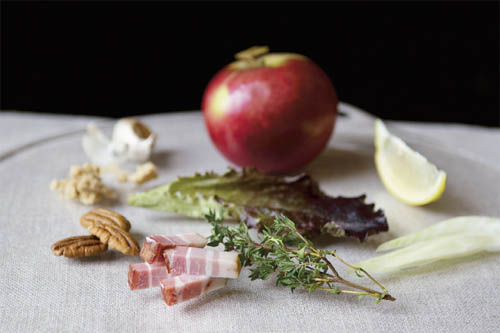
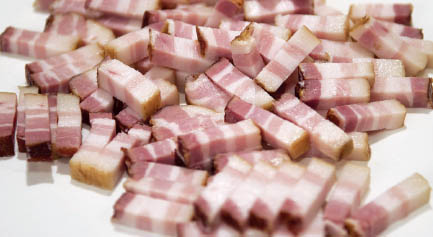
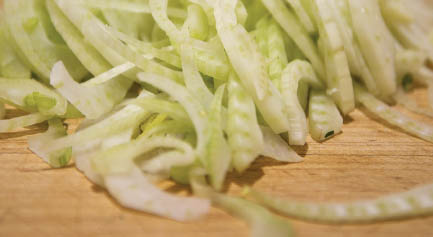
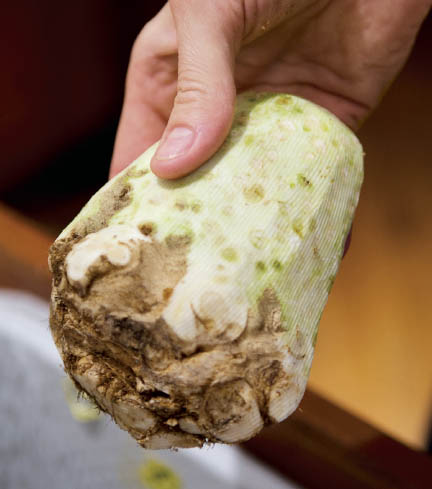
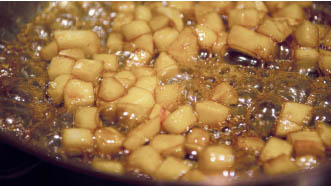
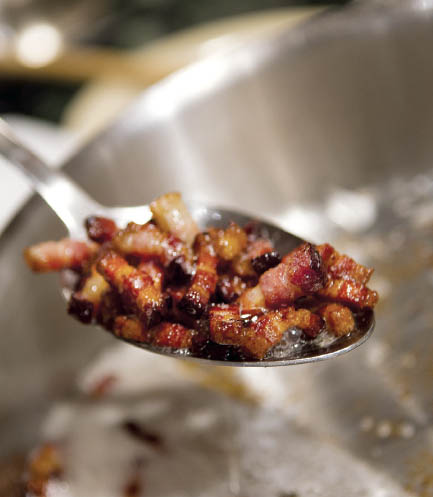
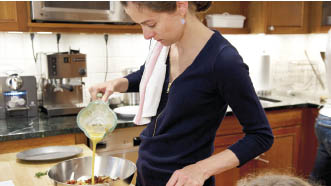
WHAT THE COMMUNITY SAID
ANTONIAJAMES: “Wanderash, seriously, you should bottle and sell this dressing. It’s one of the most delicious dressings I’ve ever tasted. It’s so good, and it works brilliantly with so many kinds of salads.”
HARDLIKEARMOUR: “I made this for dinner guests last night, and it was delicious! Great dressing, and I’m glad I’ve got some left in the fridge.”
TIPS AND TECHNIQUES
ZOE.D: “The dressing is fantastic, and I find celery works perfectly when I don’t have celery root in the house.”
LACERISE: “This recipe made me rush out to buy celery root, fennel, and just the right apples. I made the dressing, cooked my lardons, and toasted the pecans in the morning so there was very little left to do to get it on the table. Getting it off the table was easy…. It was originally meant as a side for dinner Saturday night but ended up as our main course because we couldn’t stop eating it! Dee-lish!”
WEEK 20 WILDCARD WINNER
Crispy Spice-Brined Pecans
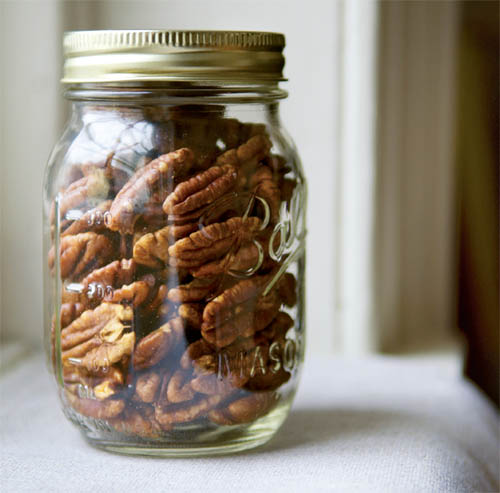
By AntoniaJames / Makes 2 cups
WHO: AntoniaJames is a lawyer who lives in the San Francisco Bay Area. She loves cooking and is “deeply grateful for having the means to create, share with others, and eat great food” (see her Haricots Verts à la Dijonnaise).
WHAT: Spiced pecans are sitting, unassumingly, on a wonderful secret, set apart from their sugar-shellacked counterparts.
HOW: The long brining and low roasting take only time and almost no effort. But here’s another secret: those times can be approximated with little ill effect.
WHY WE LOVE IT: At first glance, these nuts appear raw and untouched, but one bite betrays that they’re actually perfectly salted and spiced from within, then dried to a crisp. Even when we shaved a couple hours each off the brining and roasting times, these still disappeared from the jar. The method is based on one described by Sally Fallon in Nourishing Traditions.
2 teaspoons sea salt
½ cinnamon stick, broken into 3 or 4 pieces
½ teaspoon ground mace
3 whole cloves
Two 3-by-1-inch strips orange peel
2 cups pecan halves
1. Combine 1½ cups boiling water with the salt, cinnamon, mace, cloves, and orange peel in a glass or ceramic bowl. Cool to lukewarm, then stir well, add the nuts, and allow them to soak for 6 to 8 hours.
2. Heat the oven to 150°F. Line a baking sheet with parchment.
3. With a slotted spoon, remove the pecans from the brining liquid and spread them on the baking sheet. Remove any whole spices and orange peel. Roast for 10 to 12 hours, stirring occasionally.
4. Enjoy!! (If by chance there are any left, store them in a tightly sealed container.)
WHAT THE COMMUNITY SAID
BLISSFULBAKER: “These seem like a great gift idea!”
WEEK 21 YOUR BEST DIP
Roasted Fennel and White Bean Dip
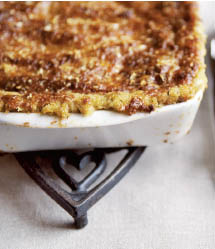
By singing_baker / Serves 12
WHO: singing_baker is a vocal and piano instructor who has a passion for food and cooking. She lives in New York City.
WHAT: An unforgettable hors d’oeuvre that will be the star of your appetizer course.
HOW: First you roast the fennel and garlic to bring out their sugars and intensify their flavors. Then you simmer white beans in fragrant garlic-and-rosemary oil. You blend the beans and fennel with more oil so the mixture lightens and, finally, you spoon it all into a baking dish, cover it with Parmesan cheese, and slide it into a hot oven so the cheese on top toasts, leaving you with a crisp veil over the pillowy dip.
WHY WE LOVE IT: Most dips involve dumping a bunch of ingredients in a bowl and mixing them until smooth. If the ingredients are good quality, you’ll end up with something worth dipping a chip into, but if you’re like singing_baker and you tweak some of those ingredients, you’ll end up with something divine. One bite, and you won’t even remember the work that went into it.
Fennel
1 large or 2 small fennel bulbs, trimmed and cut into 1-inch pieces
2 garlic cloves, unpeeled
2 to 3 tablespoons olive oil
Salt and freshly ground black pepper
Cannellini Beans
½ cup olive oil
2 garlic cloves, minced
1 tablespoon chopped fresh rosemary
2½ cups canned cannellini beans, drained and rinsed
1 tablespoon fresh lemon juice
¼ cup olive oil
½ cup freshly grated Parmesan cheese, or more if desired
Crostini for serving
1. To make the roasted fennel: Heat the oven to 400°F.
2. Toss the fennel and garlic cloves with the olive oil and spread on a baking sheet. Season generously with salt and pepper. Roast for 30 to 40 minutes, turning twice. Let cool, then squeeze the roasted garlic out of its skin. Raise the oven temperature to 450°F.
3. To make the beans: In a small frying pan, warm the olive oil over medium heat. Add the garlic and cook until lightly golden. Add the rosemary and cannellini beans and cook for 1 minute more; be careful not to burn the garlic. Take off the heat.
4. In a food processor, combine the bean mixture, fennel, roasted garlic, lemon juice, olive oil, and 5 tablespoons of the Parmesan. Puree until smooth.
5. Transfer the puree to a small baking dish and sprinkle with the remaining 3 tablespoons cheese. Feel free to add more. If your dish is nearly full, place it on a baking sheet in case it bubbles over in the oven. Bake until the cheese is golden on top, about 15 to 20 minutes.
6. Serve with crostini. Enjoy!
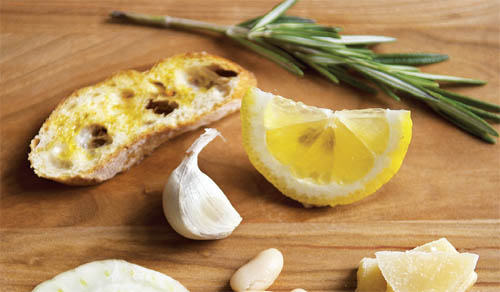
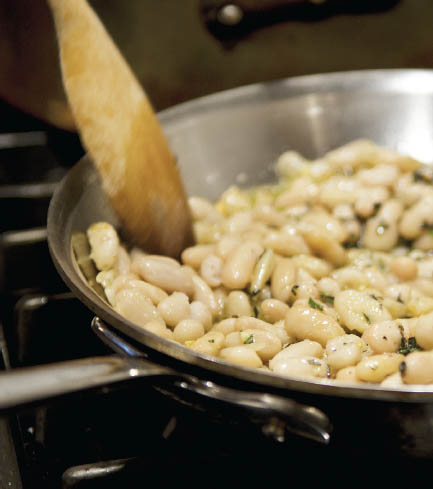
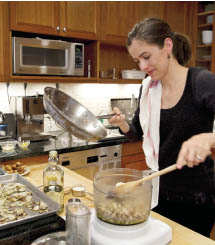
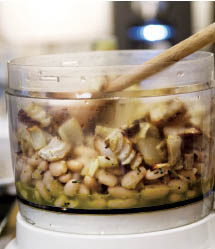
WHAT THE COMMUNITY SAID
THECRABBYCOOK: “I love this. Definitely making it for the Super Bowl, although its sophisticated elements may be a little above the heads of my football cowatchers! I’ll end up explaining to them what fennel is, they’ll end up explaining to me who the Steelers are!”
AMYW: “Folks at the Super Bowl party LOVED this dip—adults and kids alike. It’s great warm, but they loved it even at room temp. Awesome and a keeper!”
TIPS AND TECHNIQUES
BELEN_AQUINO_PERFILIO: “This dip is really yummy! We found that it gets better if you leave it overnight so the flavors can develop.”
FRISSBERG: “Quick tip for those of you who like/need to make things ahead of time: I made this the night before, then transferred it to an ovenproof serving dish (without the cheese topping), covered it in foil, and baked it at 350°F for about 30 minutes (stirring every 10 minutes or so). Then I uncovered it, sprinkled on the remaining 3 tablespoons cheese, and broiled it until brown and bubbly. Worked like a charm…. One last tip—I had some rosemary left over, so I infused it in olive oil and then used that oil to make my crostini. Delicious!”
WEEK 21 WILDCARD WINNER
Tamatar Biryani (Tomato Rice)
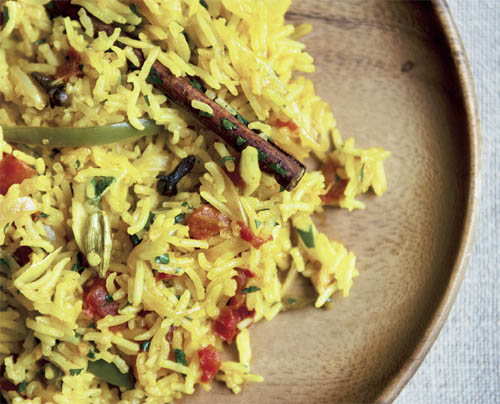
By pauljoseph / Serves 6
WHO: pauljoseph lives in Kerala, India.
WHAT: A brilliant riff on regular basmati rice that comes out perfectly cooked and infused through with tomato broth.
HOW: Vary the heat of this dish by substituting other chiles (Thai chiles are much spicier than serranos) or removing the seeds and heat-packed white ribs—bear in mind that the spice will build as you eat.
WHY WE LOVE IT: This satisfying and flavorful dish is loaded with aromatics and layers of heat but easily made for a simple side or lunch. If you can’t find whole mace, you can substitute ground or even skip it and let the other spices carry the dish.
1 cup Indian or Pakistani basmati rice
2 tablespoons ghee or unsalted butter
¼ teaspoon whole cloves
6 green or white cardamom pods
2 cinnamon sticks
2 blades mace or 1/8 teaspoon ground mace
1 small red onion, cut lengthwise in half and thinly sliced
1 teaspoon grated fresh ginger
4 medium garlic cloves, thinly sliced
2 to 3 fresh green Thai, cayenne, or serrano chiles (to taste), cut lengthwise into thin strips (do not remove the seeds)
One 14½-ounce can diced tomatoes
1 teaspoon kosher or coarse sea salt
¼ teaspoon ground turmeric
¼ cup finely chopped fresh cilantro (including tender stems)
1. Place the rice in a medium bowl. Fill the bowl with water to cover the rice and gently rub the slender grains through your fingers, without breaking them, to wash off any dust or light foreign objects (like loose husks), which will float to the surface. The water will become cloudy, drain off the water. Repeat three or four times, until the water remains relatively clear. Fill the bowl with cold water and let it sit at room temperature until the grains soften, 20 to 30 minutes; drain.
2. Heat the ghee in a medium saucepan over medium-high heat. Sprinkle in the cloves, cardamon pods, cinnamon sticks, and mace and cook until they sizzle, crackle, and smell aromatic, 15 to 30 seconds. Add the onion and stir-fry until light brown around the edges, 5 to 7 minutes.
3. Mix in the ginger, garlic, and chiles. Cook, stirring, for about 1 minute. (You don’t want the garlic to soften and brown; its nutlike crunch is important to the rice’s texture.) Stir in the tomatoes, with their juices, salt, and turmeric. Simmer, uncovered, stirring occasionally, until the tomatoes soften, 5 to 7 minutes.
4. Add the drained rice and toss gently to coat the grains with the tomato sauce. Pour in 1½ cups water and stir once to incorporate the ingredients. Bring to a boil, still over medium-high heat, and cook until the water on the surface has evaporated and craters are starting to appear in the rice, 5 to 8 minutes. Then (and not until then) stir once to bring the partially cooked layer of rice from the bottom of the pan to the surface. Cover with a tight-fitting lid, reduce the heat to the lowest-possible setting, and cook for 8 to 10 minutes. Turn off the heat and let the pan stand on the burner, undisturbed, for 10 minutes.
5. Remove the lid, fluff the rice with a fork, sprinkle with the cilantro, and serve. (Remove the cloves, cardamom pods, and cinnamon sticks before serving or just remind your guests to eat around them.)
WHAT THE COMMUNITY SAID
PANFUSINE: “Just made this for dinner (substituting crushed tomatoes for diced ones). Makes me want to quote a Sanskrit blessing: ‘Anna daata sukhi bhava! (May the person who provides you food live well and prosper!)’”
AARGERSI: “I made this for dinner last night and it was excellent—all of the seasonings are present but no one thing overpowers the other.”
WEEK 22 YOUR BEST SEAFOOD PASTA
Linguine with Sardines, Fennel, and Tomato
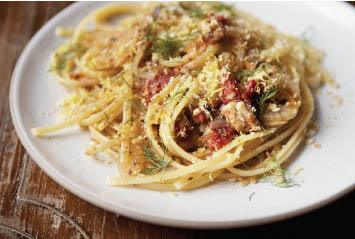
By lastnightsdinner / Serves 2 to 4
WHO: Read more about lastnightsdinner and see her Hunter’s-Style Chicken.
WHAT: A simple pantry dinner (the only thing you may have to shop for is the fennel) that packs a punch with just a few ingredients.
HOW: Perfectly al dente strands of pasta are lightly tossed in a sauce of garlic, fennel, tomato, lemon, and vermouth and studded with briny bits of sardine; the oil from the canned sardines enriches the sauce, and a shower of lemony toasted bread crumbs brightens the dish.
WHY WE LOVE IT: When we tasted this rich, sea-infused pasta dish, our first thought was, “It’s amazing that you can make something that tastes this good using fish from a can!” Lastnightsdinner said she’s been smitten with sardines “since my first taste (a long-ago birthday dinner at Prune in New York City, where my husband and I shared a starter of sardines with Triscuits, mustard, and cornichons).” One taste of this pasta, and you’ll be smitten too.
Kosher or sea salt
1 tin (about 4¼ ounces) sardines packed in olive oil
Extra virgin olive oil
2 to 3 fat garlic cloves, smashed and roughly chopped
1 small or ½ large fennel bulb, trimmed, fronds reserved for garnish, and sliced very thin (a mandoline works great)
¼ teaspoon red pepper flakes, or more to taste
1 cup canned tomatoes, with their juice, gently crushed
¼ cup dry (French/white) vermouth
2 tablespoons lemon zest
1/3 cup toasted bread crumbs
Juice of 1 medium lemon
12 ounces linguine
1. Bring a large pot of heavily salted water to a boil. Meanwhile, open the sardine tin and drain a tablespoon or so of the oil into a wide skillet (the amount of oil in the tin will vary by brand, so add olive oil if necessary to make up a tablespoon). Warm the oil over medium-low heat, then add the garlic and cook until fragrant.
2. Add the fennel to the skillet with a sprinkle of salt, raise the heat to medium, and cook until the fennel is soft and beginning to caramelize. Add the red pepper flakes and let them sizzle for a minute, just until fragrant, then add the tomatoes with their juices. Cook until the liquid has evaporated, then add the vermouth and let that simmer briefly.
3. Meanwhile, combine 1 tablespoon of the lemon zest with the bread crumbs; set aside.
4. Add the sardines to the skillet, breaking them up slightly but leaving some chunks. Add the lemon juice to the pan. Taste and add salt if necessary.
5. Add the linguine to the boiling salted water and cook until it is just short of al dente. Using tongs, transfer the linguine to the sauce to finish cooking, adding a little bit of the starchy pasta water and tossing gently to combine. (You’ll want to leave this a little wet, as the bread crumbs will soak up some of the sauce and dry the pasta out a bit when you add them.)
6. Transfer the pasta and sauce to a large warmed serving bowl (or individual pasta bowls). Add a drizzle of olive oil, sprinkle on the toasted bread crumb mixture, and garnish with the reserved fennel fronds and the remaining lemon zest.
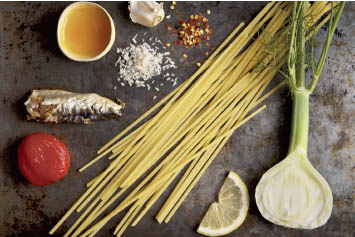
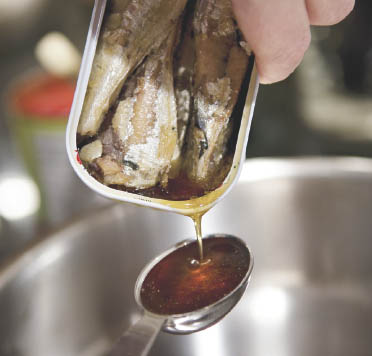
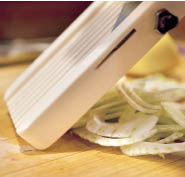
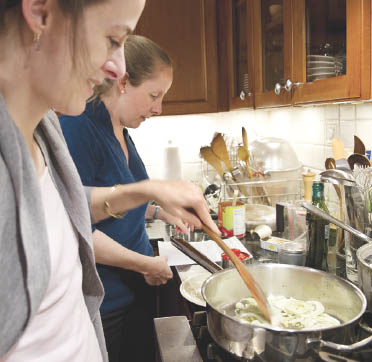
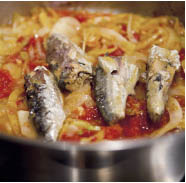
WHAT THE COMMUNITY SAID
MIDGE: “This was a cinch to make and so, so good. Going in the pasta rotation for sure.”
DEENSIEBAT: “The bread crumbs and fennel fronds totally make it—I am converted to the power of the garnish.”
MONKEYMOM: “I love that this recipe can turn humble pantry items into something stellar.”
PIERINO: “Damn! I love sardines as much as I love Jonathan Richman and the Modern Lovers. Great ideas at work here. I also love Prune when I can squeeze into that tiny place—I feel like a sardine.”
TIPS AND TECHNIQUES
A&M: We found it challenging to caramelize the fennel without burning the garlic; if you’d like, add the garlic after you’ve sautéed the fennel.
LASTNIGHTSDINNER: “It goes without saying you should use the best-quality wild-caught tinned sardines you can find. Some of our favorites are Wild Planet, Cole’s, MorGaDa, and BELA-Olhão, any of which work well here. Also, tiny fresh tomatoes are a wonderful replacement for canned during the summer months—Super Sweet 100s, left whole, or halved small cherry varieties work beautifully. Just add a pint or so to the pan in step 3 and let them cook until softened.”
PATRICIAG: “This was so incredibly delicious! I didn’t have vermouth in the house, so skipped that part. I diced a plum tomato and added that instead. Every bite had another delightful surprise. I’ll make this often.”
WEEK 22 WILDCARD WINNER
Aunt Mariah’s Lemon Sponge Cups
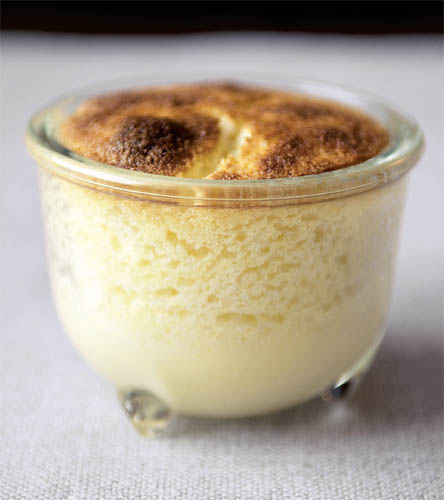
By ENunn / Serves 4 to 6
WHO: ENunn is a writer living in Chicago.
WHAT: A fresh take on lemon pudding cake.
HOW: In one fell swoop, you get two desserts: a delicate, airy cake that rises to the top and browns handsomely, and a lush lemony custard that pools at the bottom, waiting for your spoon.
WHY WE LOVE IT: We’re so glad ENunn unearthed her Aunt Mariah’s version of classic lemon pudding cake—its evocative name, mellowed lemon pucker, and bare sweetness thoroughly won us over.
2 tablespoons unsalted butter, at room temperature
1 cup sugar
¼ cup all-purpose flour
Pinch of salt
Grated zest and juice of 1 lemon
3 large eggs, separated
1½ cups whole milk
Whipped cream for serving
1. Heat the oven to 350°F.
2. In a large bowl, cream the butter. Beat in the sugar, flour, salt, and lemon zest and juice.
3. In a small bowl, beat the egg yolks. Stir in the milk. Slowly add the second mixture to first mixture.
4. Beat the egg whites until stiff; gently fold into the batter. Pour it into ramekins or individual soufflé dishes and place in a baking pan of hot water. Bake for 45 minutes. You will have a layer of lemon custard with a gorgeous lightly browned sponge on top. Let cool a bit.
5. Turn out and serve with whipped cream, or serve in the ramekins.
WHAT THE COMMUNITY SAID
MRSWHEELBARROW: “Love this recipe! It’s like a lemon bar and a lemon soufflé all in one.”
CHEZSUZANNE: “I just got an e-mail from one of my cousins, who lives next door to Aunt Mariah’s daughter—your cousin?—and is her business partner, and just had these for dessert tonight at her home. That’s gotta win a prize for ‘it’s a small world’! My cousin described these as luscious. Now I have to make them!”
TIPS AND TECHNIQUES
ENUNN: “Make sure you use a big fresh lemon, not some old ratty thing. You can also bake this in one large soufflé dish. Aunt Mariah likes to garnish it with a thin slice of lemon.”
WEEK 23 YOUR BEST RECIPE WITH CARDAMOM
Clementine Pound Cake
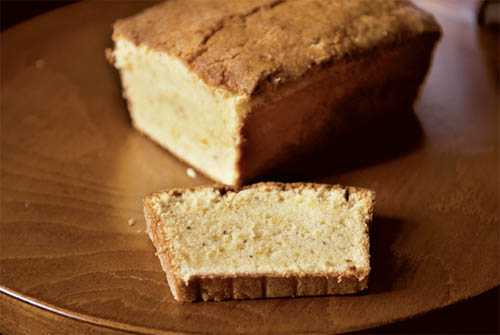
By SavvyJulie / Serves 10 to 12
WHO: SavvyJulie lives in Ithaca, New York, and blogs about healthy living at www.savvyeat.com.
WHAT: A delicately spiced pound cake to bring out at teatime and dessert alike.
HOW: The recipe showcases citrus and cardamom by setting them against the backdrop of a pitch-perfect loaf cake.
WHY WE LOVE IT: The crumb is tender and melting, and the rich brown crust is as paper-thin and brittle as an eggshell, crunching pleasantly between your teeth. The perfume of the clementine zest and juice permeate the entire cake, and the cardamom (which we recommend you grind fresh) makes the party official. While this would be great with a dollop of ice cream, it certainly doesn’t need it.
12 tablespoons (1½ sticks) unsalted butter, at room temperature, plus more for the pan
1¾ cups all-purpose flour, plus more for the pan
2 tablespoons olive oil
1¼ cups sugar
¼ cup packed light brown sugar
3 large eggs
½ teaspoon salt
1¼ teaspoons vanilla extract
1 teaspoon ground cardamom
1 tablespoon grated clementine zest (from about 2 clementines)
¼ cup fresh clementine juice (from about 2 clementines)
¼ cup milk
1. Heat the oven to 350°F. Butter and flour a 9 x 5 x 3-inch loaf pan.
2. In the bowl of a stand mixer fitted with the paddle attachment, or using a hand mixer in a large bowl, cream the butter, olive oil, and sugars together on medium speed until smooth and light, 3 to 5 minutes. With the mixer on medium speed, mix in the eggs one at a time until completely blended, scraping down the sides of the bowl after each addition. Beat in 1 cup of the flour, followed by the salt, vanilla, cardamom, clementine zest, and juice. Add the milk and the remaining ¾ cup flour. Beat just until the batter is smooth and consistent—do not overbeat!
3. Scrape the batter into the prepared pan and smooth the top. Bake for 1 hour and 15 minutes, or until the edges are browned and just pulling away from the sides of the pan and a cake tester inserted in the middle of the cake comes out clean. Allow to cool for 10 minutes in the pan.
4. Run a knife or spatula around the edges of the cake to release it from the pan, and flip onto a wire rack to cool completely before slicing and serving.
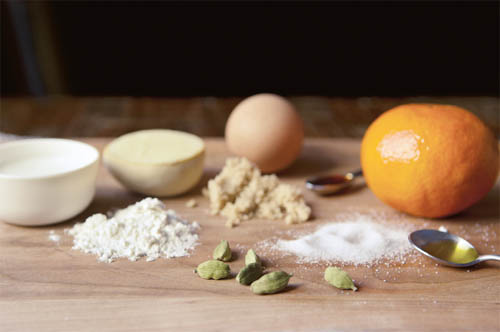
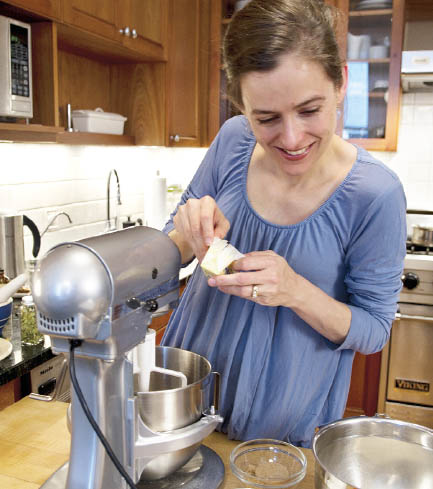
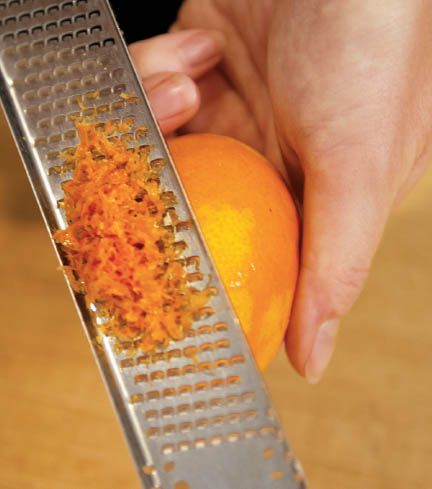
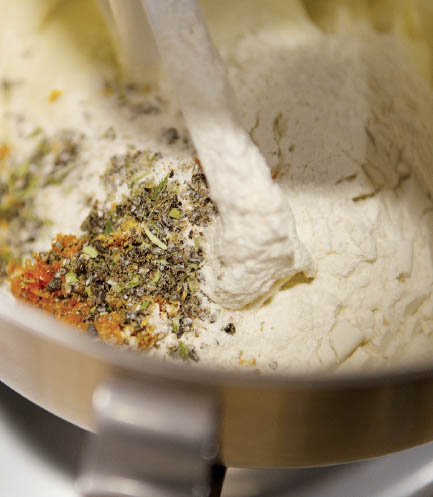
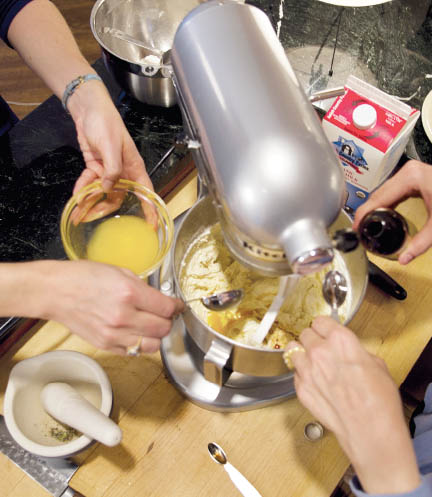
WHAT THE COMMUNITY SAID
RIVKA: “Cake’s in the oven now. I haven’t licked this much batter in years—divine! Planning to serve with fresh strawberry compote. Very excited.”
TIPS AND TECHNIQUES
SAVVYJULIE: “When you make this cake, you have to let it cool completely. All the way. It will be tough: You’ll want to cut into the rich goodness immediately. You’ll want to taste the citrus on your tongue, feel a bite of the cake melt in your mouth. But you must be patient. Just trust me on this one. You don’t want a crumbly cake, now, do you? With this dessert, you only need a small piece. It is that rich. And that delicious. A little goes a long way.”
ANTONIAJAMES: “The key to making any pound cake turn out, regardless of whether it has a chemical leavener, is to beat the butter and sugar for a good long time, until they are practically white and almost look like frosting, at the outset.”
WEEK 23 WILDCARD WINNER
Gong Bao Ji Ding (Gong Bao Chicken)
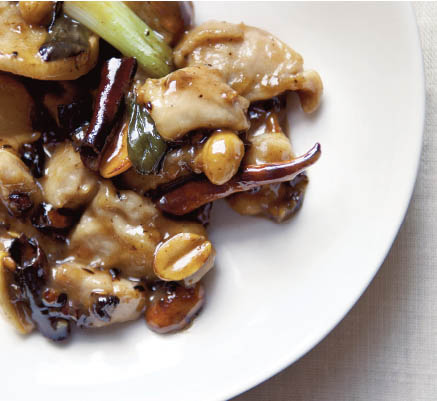
By FrancesRenHuang / Serves 2
WHO: FrancesRenHuang lives in Buenos Aires. When she’s not thinking about food, she is an acupuncturist and yoga teacher.
WHAT: A brilliant stir-fry that comes together in the time it takes to cook an accompanying pot of rice for dinner.
WHY WE LOVE IT: Tender morsels of chicken eagerly soak up a fragrant, velvety sauce in what is a remarkably quick and forgiving recipe. If you can’t find Sichuan peppercorns, don’t sweat it (you’ll just miss out on their mysteriously addicting numbing quality).
½ teaspoon beaten egg
1 tablespoon plus 2 teaspoons cornstarch
Pinch of salt
1 teaspoon Chinese cooking wine
2 medium chicken thighs (3 to 4 ounces each), deboned and cut into ½-inch cubes
2 teaspoons light brown sugar
6 tablespoons chicken stock, low-sodium broth, or water
1 tablespoon Chinese black vinegar
2 teaspoons dark soy sauce
½ cup vegetable oil
8 dried red chiles, chopped
4 teaspoons Sichuan peppercorns, plus ground pepper for serving
4 garlic cloves, smashed and chopped
6 thin slices fresh ginger
2 scallions, cut into 1-inch lengths
A generous handful of peanuts
Steamed rice for serving
1. In a medium bowl, whisk together the egg, 2 teaspoons of the cornstarch, the salt, and wine. Toss with the chicken to coat, and set aside. (You can refrigerate this for up to 12 hours if you’d like.)
2. In a small bowl, stir together the brown sugar, stock, vinegar, soy sauce, and the remaining 1 tablespoon cornstarch; set aside to use for the sauce later.
3. Set a wok or large skillet over medium-high heat, add the oil, and heat until the oil is shimmering. Add half the chicken to the wok and cook, stirring frequently, until it is just half-cooked, about 2 minutes. Remove the meat with a slotted spoon and set aside on a plate. Repeat with the rest of the chicken.
4. Drain off all but 2 tablespoons of the oil from the wok. Throw in the chiles, peppercorns, garlic, ginger, and scallion and stir-fry until fragrant, about 2 minutes. Add the peanuts and stir-fry for another 1 to 2 minutes. Return the chicken to the wok and stir-fry for 2 minutes. Add the reserved sauce ingredients and simmer until the sauce thickens and the chicken is cooked through, about 3 minutes.
5. Garnish with ground Sichuan pepper and serve with rice.
WHAT THE COMMUNITY SAID
HEALTHIERKITCHEN: “I made this for dinner tonight and it was terrific! I did grind the peppercorns a little in a suribachi…. The sauce was perfect—a welcome change from the sickly sweet sauce found in many restaurants in the United States.”
DRBABS: “Okay, so my husband sat down at the table and said, ‘Wow, this smells like real Chinese food!’ It was fabulous!”
TIPS AND TECHNIQUES
FRANCESRENHUANG: “Dark soy sauce is darker and thicker, contributing to a beautiful dark color and also a richer flavor, but regular soy sauce is fine as well! Feel free to use any small dried red chiles that suit you. And customize at will by adding sliced mushrooms, water chestnuts, or diced celery to the stir-fry.”
WEEK 24 YOUR BEST RECIPE WITH CITRUS AND OLIVES
Chicken That Fancies Itself Spanish, with Lemons, Onions, and Olives
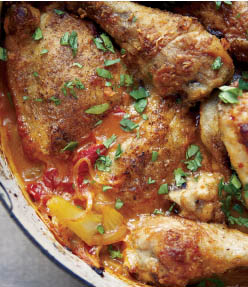
By MeghanVK / Serves 4 to 6
WHO: MeghanVK is a television programmer living in Brooklyn, New York.
WHAT: Show-stopping chicken dinner—an oxymoron no longer!
HOW: A perfect blend of pecorino, flour, and smoked paprika coats the chicken, rendering it shaggy and crisp when browned, and the inclusion of both lemon zest and quartered lemons, plus a dash of cinnamon, lends toasty warmth.
WHY WE LOVE IT: It was the attention to detail in this cleverly adapted and absolutely delicious recipe that won us over. We found that the tenor of the smoky, tangy sauce depended on the quality of the lemons; if your lemons have a thick rind, you’ll want to add just their zest and juice (as described below) to avoid a bitter sauce.
½ cup plus 1 tablespoon all-purpose flour
¼ cup freshly grated pecorino cheese
1 tablespoon smoked paprika
¼ cup olive oil
One 4-pound chicken, cut into serving pieces
Salt and freshly ground black pepper
3 medium lemons
2 large yellow onions, sliced
1 large fennel bulb, trimmed, halved, and sliced
12 garlic cloves
¾ cup pitted green olives
Pinch of ground cinnamon
1 cup canned whole tomatoes, crushed
1 cup dry white wine
1 bunch fresh cilantro, leaves and tender stems roughly chopped
1. Heat the oven to 425°F.
2. Combine ½ cup of the flour with the pecorino and 1 teaspoon of the smoked paprika in a large bowl.
3. Heat the olive oil in a large ovenproof heavy pot (such as a Dutch oven) over medium-high heat. Dry the chicken parts thoroughly with paper towels and sprinkle generously with salt and pepper on all sides. Working in batches, dredge the chicken in the seasoned flour and add to the pot—don’t crowd it! Allow the chicken to brown thoroughly about 5 minutes per side. Remove the chicken to a plate and repeat until all of the chicken pieces are golden and crispy-looking. Set the pot aside.
4. Zest one of the lemons; reserve the zest. Quarter all the lemons. (If your lemons have a thick rind, zest all 3, then juice them, discarding the rinds; this will avoid a bitter sauce.) Add the onions, quartered lemons (or the zest of 2 lemons and the juice of all 3), fennel, garlic, olives, cinammon, and the remaining 2 teaspoons smoked paprika, and the cinnamon to the pot on medium-low heat. Cook until the onions and fennel are softened, golden, and overall mushy-looking, about 10 minutes. Taste for salt. Sprinkle the mixture with the remaining tablespoon of flour and stir for 2 minutes. Add the tomatoes and wine, bring to a boil, and let bubble away for a minute or two. Add the lemon zest (or the zest of the third lemon if you are using only zest and juice).
5. Place the chicken pieces back into the pot, skin side up, along with any drippings from the plate. Poke at the onion-fennel-garlic-olive mixture until it surrounds the chicken on all sides. Bake, uncovered, for 30 minutes, or until the chicken is cooked through.
6. Garnish with the cilantro and serve. Delicious!
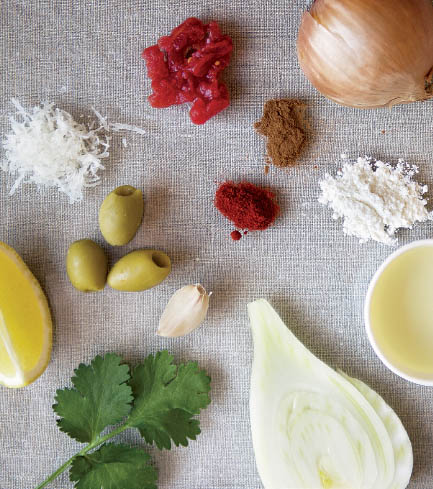
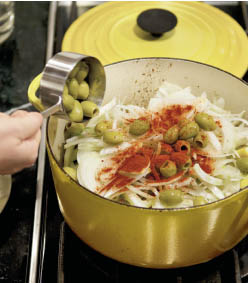
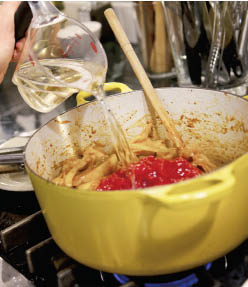
WHAT THE COMMUNITY SAID
SHOESTHATILIKE: “Made this for a dinner party on Friday night. Huge hit. It was very easy to prep and only required one pot. I will make it again!”
FRESCA: “I’ve made this twice this week. I never make anything twice, ever. That is how much we love this.”
CHEF JAMIE B.: “This was excellent, even enjoyed as leftovers! I loved the combo of flavors, and the chicken was very tender. I served it with rice, which was a delicious pairing! I will definitely be making this again!”
TIPS AND TECHNIQUES
MEGHAN VK: “You can also try using red wine instead of white in the sauce—very different flavor!”
WEEK 24 WILDCARD WINNER
Creamy Potato Soup with Bacon Vinaigrette

By OB Cookie / Serves 6
WHO: OB Cookie is an OB/GYN resident and baby-catcher extraordinaire. She lives in Dallas, Texas, and blogs at www.obcookie.blogspot.com.
WHAT: A thick, creamy soup full of tang from a good hit of sour cream, topped with bacon.
HOW: This soup is made mostly from things that are probably sitting in your fridge right now. Is there anything better?
WHY WE LOVE IT: OB Cookie said, “I wrote this recipe when I was having a down day. Simmering homemade stock all day lifted my spirits.” No wonder the recipe cheered her up! The soup on its own is a bowl of comfort, but the bacon and scallion vinaigrette really brings the dish to life. You might be wondering, as we were, about not including some of the bacon fat in the dressing, but trust us—this keeps the whole thing bright and perky. Of course, for you gluttons out there, it’s always an option.
Soup
1 tablespoon unsalted butter
1 large onion, chopped
1 large carrot, peeled and chopped
1 celery stalk, chopped
3 garlic cloves, chopped
1 fresh rosemary sprig, chopped
1 teaspoon salt
6 medium russet potatoes (about 2 pounds), peeled and cut into 1-inch cubes
7 cups chicken stock, low-sodium broth, or water
1 cup low-fat sour cream
Freshly ground black pepper
Vinaigrette
4 slices thick-cut bacon
3 scallions, thinly sliced
3 tablespoons white wine vinegar
Pinch of salt
2 tablespoons extra virgin olive oil
1. To make the soup: Melt the butter in a large pot over medium-high heat. Add the onion, carrot, celery, garlic, rosemary, and salt and cook until the onions are soft, about 10 minutes.
2. Add the potatoes and stock and bring to a boil, then reduce the heat and simmer until the potatoes are very tender, about 20 minutes.
3. Remove from the heat and add the sour cream. Puree in a regular blender and return to the pot, or use an immersion blender. Add pepper to taste and keep warm.
4. To make the vinaigrette: Cook the bacon in a large skillet over medium-high heat until crisp. Drain on paper towels, then chop into small pieces.
5. In a small bowl, stir together the bacon, scallions, vinegar, and salt. Stir in the oil.
6. Serve the soup garnished with about 1 tablespoon vinaigrette per bowl.
WHAT THE COMMUNITY SAID
MRSWHEELBARROW: “Lovely idea for a soup with tang. I have every single ingredient, so it won’t be long before this is on our dinner table.”
FRANCESRENHUANG: “A great comfort dish for a rainy day.”
ANTONIAJAMES: “Whoa!!! I’m making this! Sounds like my absolute fave, German potato salad, in a bowl!! Brilliant.”
WEEK 25 YOUR BEST FONDUE
Coconut Cajeta and Chocolate Fondue
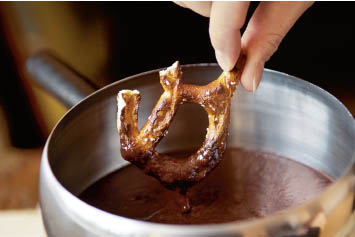
By hardlikearmour / Makes about 2½ cups
WHO: hardlikearmour is a veterinarian and amateur baker and cake decorator living in Portland, Oregon. See her State Fair Cream Puffs.
WHAT: A chocolate and caramel fondue, with a little coconut milk for good measure.
HOW: The silken, almost custardy fondue is punctuated with rum and vanilla, then generously salted (the way we like our caramel to be).
WHY WE LOVE IT: Not surprisingly, this fondue is gloriously rich and sweet. We found our favorite dipping instrument to be salty extra-dark pretzels. We highly recommend you try the combination.
HARDLIKEARMOUR: “This dessert fondue is inspired by a coconut dulce de leche recipe from Bon Appétit magazine that I found on www.epicurious.com. I’ve made it multiple times and have tweaked it a bit to my liking. My most major change is the addition of chocolate. It took a bit of experimenting to figure out the proportions so the chocolate doesn’t overwhelm the more delicate caramel flavor. If you are not a coconut fan, don’t fear—the coconuttiness is pretty subtle if you use vanilla extract and plain rum or cognac. This fondue is so luscious that you really won’t believe there’s no cream or butter in it. NB: This recipe can be made vegan, as long as you track down vegan turbinado sugar and use vegan dark chocolate.”
Two 13½-ounce cans regular coconut milk (I use Chaokoh brand or another high-fat version)
1 cup packed light brown sugar
¾ teaspoon Diamond kosher salt (if using table salt, scale back to ½ teaspoon)
3 ounces bittersweet chocolate, finely chopped
2 teaspoons vanilla or coconut extract
3 tablespoons dark rum, coconut rum, or cognac (optional)
1. Combine the coconut milk, brown sugar, and salt in a 12-inch or larger, heavy skillet and heat over medium heat, stirring occasionally until the sugar dissolves. Increase the heat to medium-high and cook until the coconut milk is reduced and thickened, stirring more frequently as the mixture thickens; this should take 15 to 20 minutes. The mixture will become darker and the bubbles will go from being somewhat frothy to looking more like bubbling lava. A wooden spoon or heatproof spatula scraped along the bottom from one side to another should leave a trail that “heals” within a few seconds. When this happens, remove the mixture from the heat.
2. Add the chocolate and wait about 1 minute, then stir to melt and incorporate. Once the chocolate is fully melted, stir in the vanilla and rum, if using.
3. Transfer to a fondue pot or ceramic bowl. (If you’re using a fondue pot, make sure the heat is low, to prevent scorching.) Serve with fresh fruit (chunks of bananas or pineapple, strawberries, and so on), angel food or pound cake cubes, or salty pretzels.
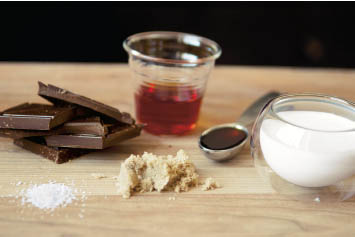
WHAT THE COMMUNITY SAID
SPORK: “Delicious! And leftovers were great in coffee.”
GREENSTUFF: “This sounds amazing! A huge increase in sophistication from the Toblerone, cream, and cognac chocolate fondue of the 1970s.”
MRSLARKIN: “Oh, yes! Like a liquid Mounds bar. You could dip almonds into it, if you felt like a nut.”
TIPS AND TECHNIQUES
HARDLIKEARMOUR: “If you are not a fan of chocolate, feel free to omit it. Without it, the flavor is a good balance of caramel and coconut.
“You can make the whole thing ahead, and then either put it in a microwave-safe bowl and heat at 50% for several minutes, stirring occasionally until warmed through, or put it in a metal bowl and heat over a pan of water, like a double boiler. It can be served either warm or at room temperature (has a more puddinglike texture at room temperature). I store it in a tightly sealed container in the fridge.
“I think coconut rum would also be great, especially if you’re a coconut fan! I’m a huge coconut fan but am aware not everyone is. You could also go with coconut extract in place of vanilla if you wanted more coconuttiness.”
WEEK 25 WILDCARD WINNER
Shrimp Gumbo
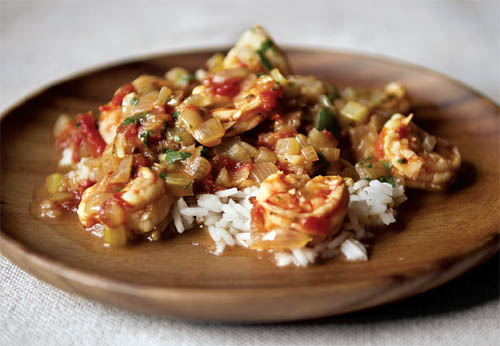
By drbabs / Serves 2 to 4
WHO: drbabs is an optometrist and food lover living in Huntington, New York. See her Ginger Apple Torte.
WHAT: A perfect weeknight gumbo featuring vegetables and plenty of meaty shrimp.
HOW: The smoky dark roux and well-chosen cocktail of spices pull in all the right flavors and kick.
WHY WE LOVE IT: drbabs, a former New Orleanian, has streamlined and lightened the Cajun classic. By design, this recipe can be made year-round from pantry staples, but you could always put a little Mardi Gras in it by adding andouille or tasso.
DRBABS WRITES: “In Louisiana, gumbo is practically religion. I wanted a lightened-up version of traditional seafood gumbo, and this is what I came up with. As with most soups, the seasonings can be adjusted according to your taste.”
2 tablespoons grapeseed oil
2 tablespoons all-purpose flour
2 large onions, finely chopped
2 celery stalks, finely chopped
1 garlic clove, put through a garlic press or minced
Salt and freshly ground black pepper
1 pound medium shrimp, peeled and deveined, shells rinsed and reserved
1 cup chopped tomatoes (fresh is best, but in winter, I use Pomì chopped tomatoes)
½ teaspoon dried thyme
½ teaspoon dried oregano
½ teaspoon smoked paprika
¼ teaspoon cayenne pepper
Juice of ½ lemon
1 tablespoon Worcestershire sauce
2 tablespoons chopped fresh flat-leaf parsley
Tabasco sauce
White or brown rice for serving
1. First, make a roux: In a large cast iron Dutch oven, heat the oil over medium-low heat. Sprinkle the flour over the oil and stir until it’s completely blended. Continue cooking for 5 to 10 minutes, stirring occasionally, until the roux browns and is dark caramel colored. (Be careful not to let it burn.)
2. Stir in the onions, celery, and garlic. Sprinkle in ¼ teaspoon salt and a few turns of pepper and stir well. Cover the pot and let the vegetables cook in the roux until softened, 5 to 7 minutes.
3. While the vegetables are cooking, put the shrimp shells in a medium saucepan, cover with 2 cups water, and add a good pinch of salt. (The shells should be just covered; add more water if they’re not.) Bring the water to a boil, then reduce the heat to a simmer. Simmer for a couple of minutes, until the shells are bright pink. Remove from the heat.
4. Add the tomatoes, thyme, oregano, paprika, cayenne, lemon juice, and Worcestershire sauce to the vegetables in the Dutch oven. Strain the shrimp cooking liquid into the soup, stir, and let simmer, uncovered, for about 20 minutes.
5. Stir in the shrimp and let them simmer until just firm and cooked through, 3 to 5 minutes, depending on their size. Taste and adjust the seasoning.
6. Stir in the parsley and a couple of drops of Tabasco (a little goes a long way!) and serve in bowls with a large scoop of rice, and more Tabasco on the side.
WHAT THE COMMUNITY SAID
PIERINO: “Cooked a big batch up for Valentine’s Day, and, yes, I did use tasso, and I did use okra and a dark roux. Got raves except for two wimpolas who only eat bland foods.”
TIPS AND TECHNIQUES
ARATHI: “I made this a couple of days ago and it was excellent! I added andouille and okra and threw in some filé powder I happened to have at the end. It was so, so good! Thank you so much for the recipe, I will make this again and again.”
WEEK 26 YOUR BEST PUDDING
Burnt Caramel Pudding
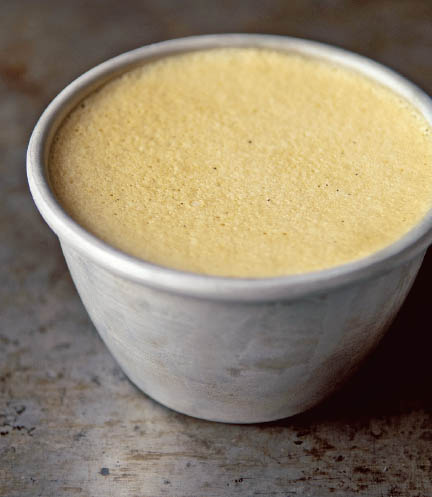
By Midge / Serves 4
WHO: Midge lives in Boston and is a journalist specializing in travel. She says, “Cooking, especially baking, is my way of winding down after a long day.” See her Grown-Up Birthday Cake and Okonomiyaki.
WHAT: A rich pudding that has just the right balance of bitter and sweet.
HOW: Starting the water bath with cool water, rather than hot, cooks the pudding very gently, giving it the most incredibly silken, glossy structure.
WHY WE LOVE IT: Puddings thickened with cornstarch make great comfort food, but Midge’s luxurious caramel custard, which uses egg yolks as its only setting agent, elevates pudding to dinner-party fare. As with any egg-enriched custard, the key is careful tempering. As for the caramel, be sure to brown it as far as your nerves allow.
MIDGE SAYS: “So far, one of the best parts about living in Boston is my proximity to Toscanini’s burnt caramel ice cream. I’m not even that into ice cream, but this flavor, with its slight bitter edge to cut the richness, is cracklike. I attempted to capture it in a pudding, and after incinerating a lot of sugar, I think I finally got it.”
2 cups heavy cream
½ vanilla bean
½ cup sugar
3 large egg yolks, at room temperature
Fine sea salt
Whipped cream for serving
1. Heat the oven to 300°F.
2. Pour the cream into a small saucepan. Split the vanilla bean and scrape the seeds into the cream; toss the scraped pod in there too. Turn the heat to low to gently warm the cream.
3. Reserve 2 tablespoons of the sugar. Pour the remaining sugar and the 1½ tablespoons of water into a heavy-bottomed saucepan, set over medium heat, and stir until the sugar dissolves. Then crank the heat to high and let the liquid bubble away—don’t stir, just swirl the pan occasionally—until it turns dark amber. This takes about 4 minutes, but watch closely, because it happens fast. Reduce the heat to medium.
4. Moving quickly, fish the vanilla pod out of the cream (rinse it and save for another use) and slowly stir the warm cream into the caramel. Once it comes to a boil (this will happen fast), remove from the heat and let the mixture cool for about 10 minutes.
5. Whisk the egg yolks with the reserved sugar and a pinch of sea salt in a medium bowl. Whisk a little of the cream-caramel mixture into the egg yolks, then gradually whisk in the rest until it’s all incorporated.
6. Strain the mixture into a pitcher or large measuring cup and pour it into four 6-ounce ramekins (see Tips and Techniques). Place the ramekins in a shallow baking pan filled halfway with cold water. If you like your caramel a bit salty, like me, sprinkle a few grains of sea salt on top of each pudding. Cook for 1 hour to 1 hour and 15 minutes, until just set.
7. Chill the puddings for at least 3 hours; but it’s best if you can chill them overnight. Serve with freshly whipped cream.
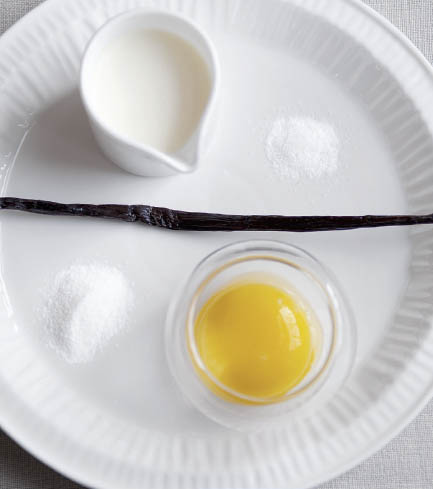
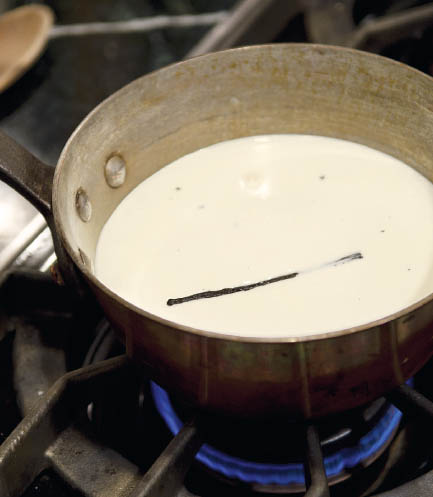
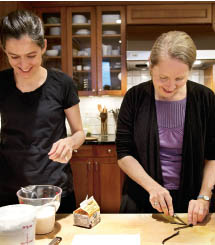
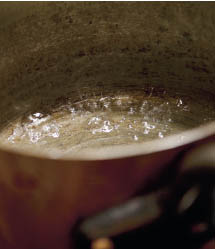
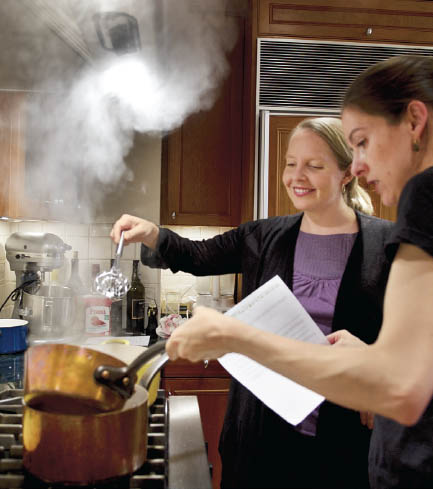
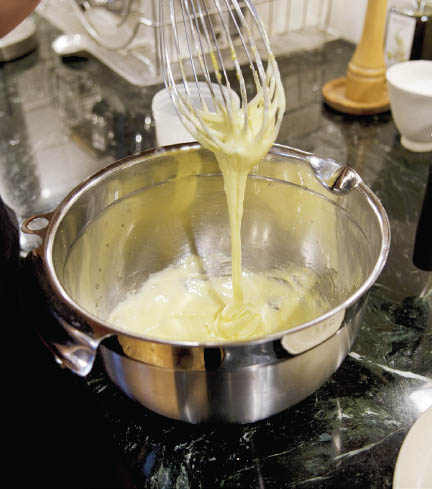
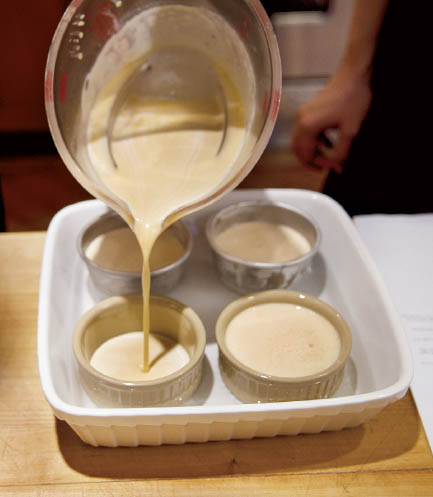
WHAT THE COMMUNITY SAID
WOODSIDE: “Just the right amount of rich, and ultrasmooth and creamy. Simple, and definitely guest-worthy.”
PANFUSINE: “Congratulations, Midge…. Such an elegant recipe, with exactly five ingredients! Awesome!”
PERFECTCHAOS: “Thank you, Midge, for this fun offering; I white-knuckled during the sugar browning, only swirling the pan now and then, but you are absolutely correct with the 4-minute time frame. All was so easy, and the custard has an amazing depth of flavor finish!”
TIPS AND TECHNIQUES
MIDGE: “I used some old custard cups that hold about 5 ounces, but 6-ounce ramekins should be fine.”
WEEK 26 WILDCARD WINNER
Roasted Broccoli with Smoked Paprika Vinaigrette and Marcona Almonds
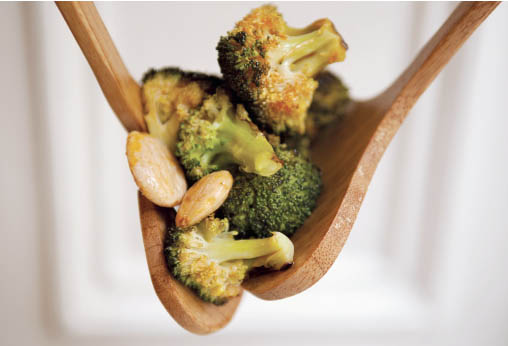
By arielleclementine / Serves 2
WHO: arielleclementine, who lives in Austin, Texas, is a stay-at-home mom and enthusiastic home cook.
WHAT: A better broccoli side dish, upgraded with the addition of smoked paprika and Marcona almonds.
HOW: Broccoli, roasted to enhance its natural sweetness, is combined with mellow sherry vinegar and the earthy, peppery bite of oil infused with smoked paprika and garlic.
WHY WE LOVE IT: arielleclementine’s recipe is both easy enough to make every night and unusual enough to save for special occasions. And, in our opinion, Marcona almonds, buttery and rich, are a great addition to pretty much anything.
Broccoli
1 bunch broccoli, cut into florets
Extra virgin olive oil, for drizzling
Kosher salt
Vinaigrette
¼ cup extra virgin olive oil
1 garlic clove, minced
1 teaspoon sweet smoked paprika
1½ tablespoons sherry vinegar
Kosher salt
¼ cup Marcona almonds
1. Heat the oven to 425°F.
2. On a large baking sheet, toss the broccoli florets with a drizzle of olive oil and a hefty sprinkling of kosher salt. Roast for 20 minutes, until brown in spots.
3. While the broccoli is roasting, make the vinaigrette: Heat the olive oil in a small skillet over medium heat until quite warm, about 2 minutes. Stir in the garlic and smoked paprika and remove the pan from the heat; let stand for 10 minutes.
4. Put the sherry vinegar and a pinch of salt in a small bowl. Slowly whisk in the paprika oil. Try to leave most of the solids (paprika and garlic) in the skillet.
5. After 20 minutes, remove the broccoli from the oven and toss the Marcona almonds on top. Drizzle with a few tablespoons of the vinaigrette, toss, and serve immediately.
WHAT THE COMMUNITY SAID
OUI, CHEF: “I can’t tell you how many times I’ve made this dish; it is one of my absolute favorites.”
LUVCOOKBOOKS: “This is the potato chip of broccoli—irresistible and easy to make!”
ENUNN: “I’m having this again tonight with a fried egg. It is so good.”
TIPS AND TECHNIQUES
HELENTHENANNY: “Congratulations, sister! It’s original and yummy and fun! And I especially liked the part when I got to eat the leftovers the next day mixed into a big pot of buttered noodles!”